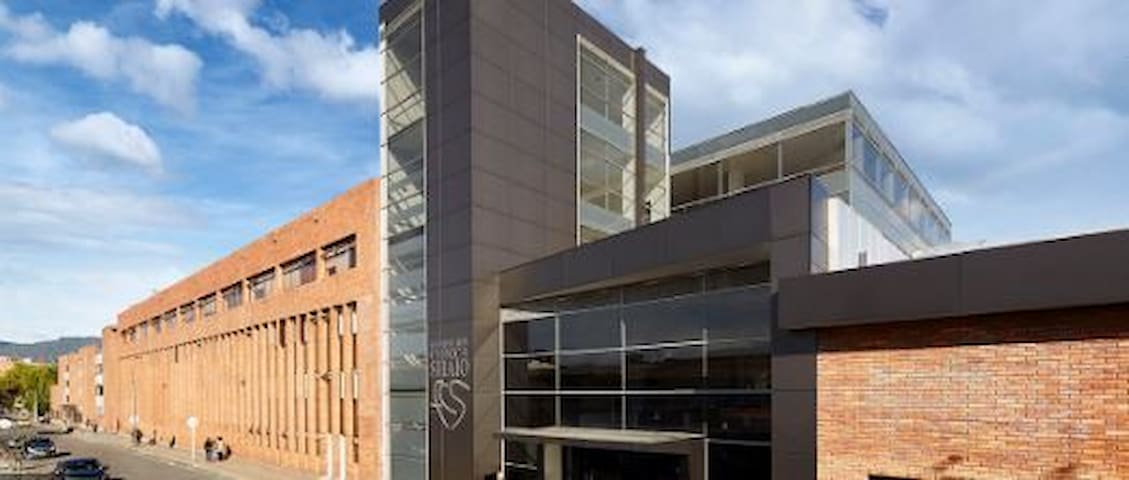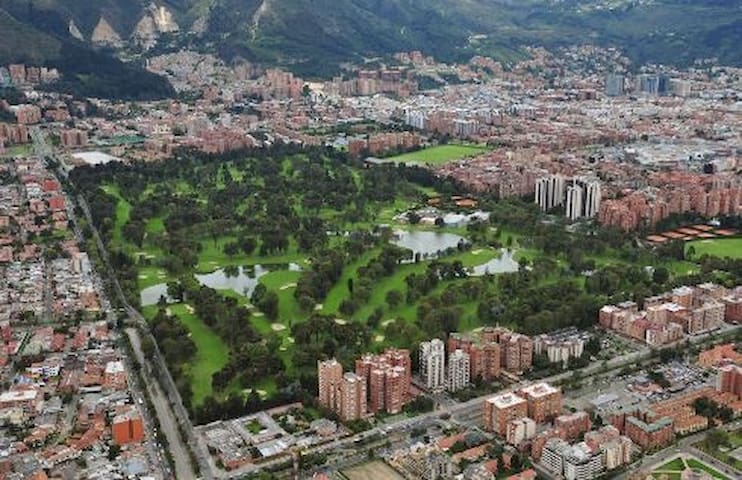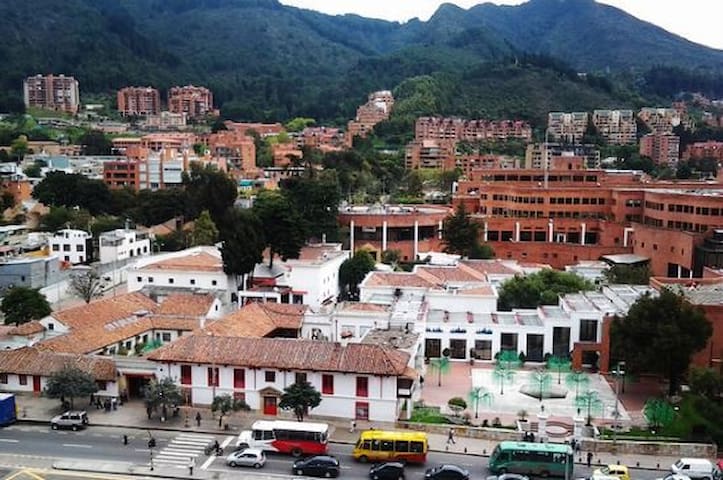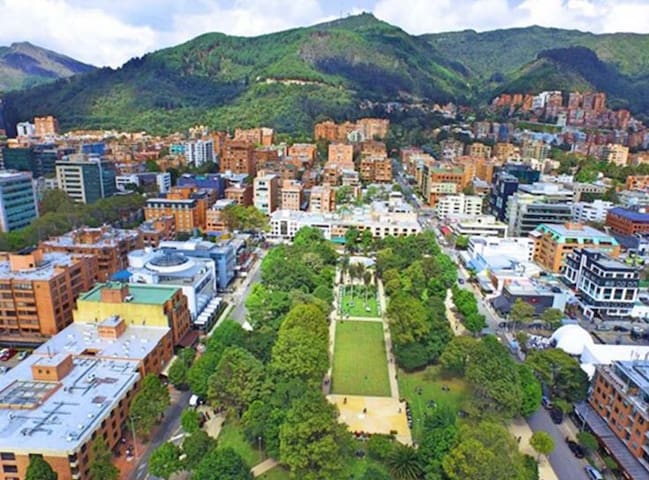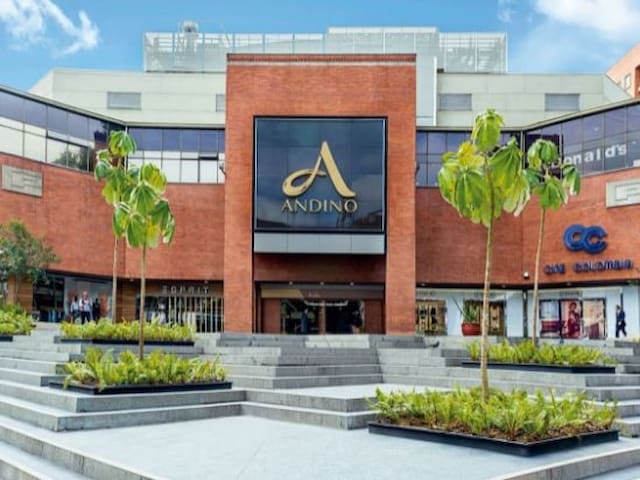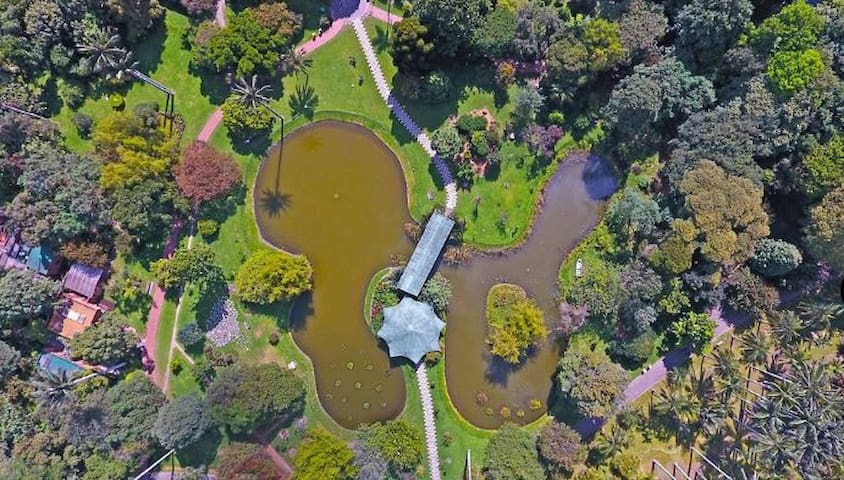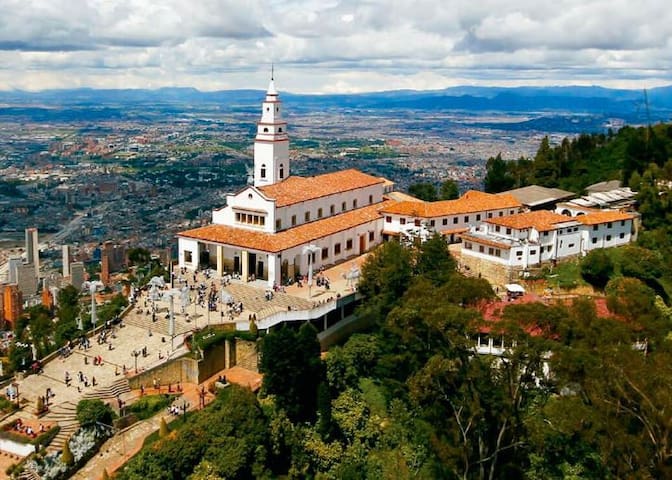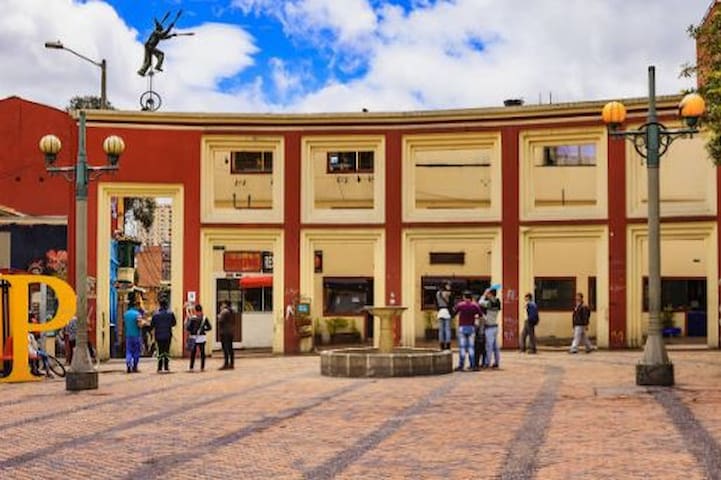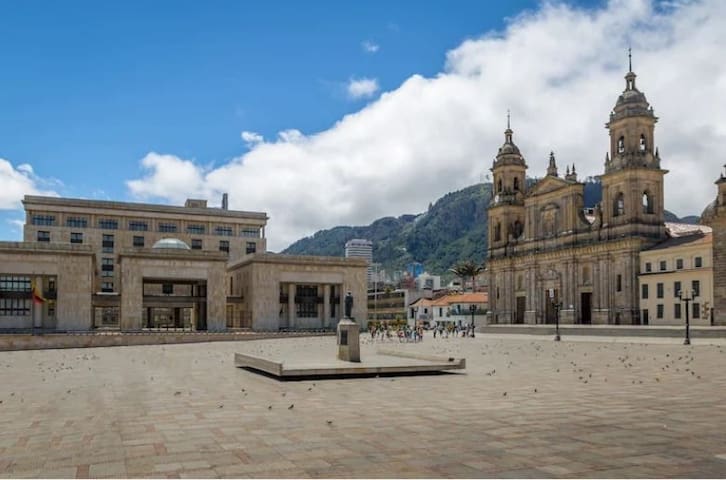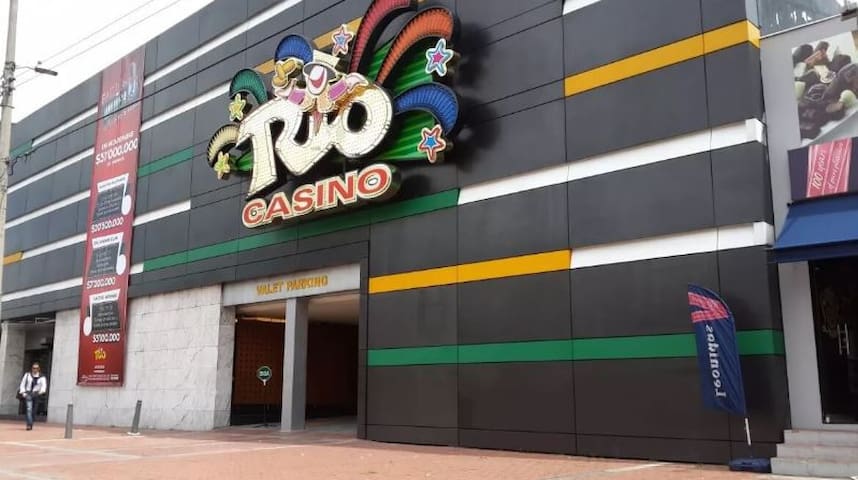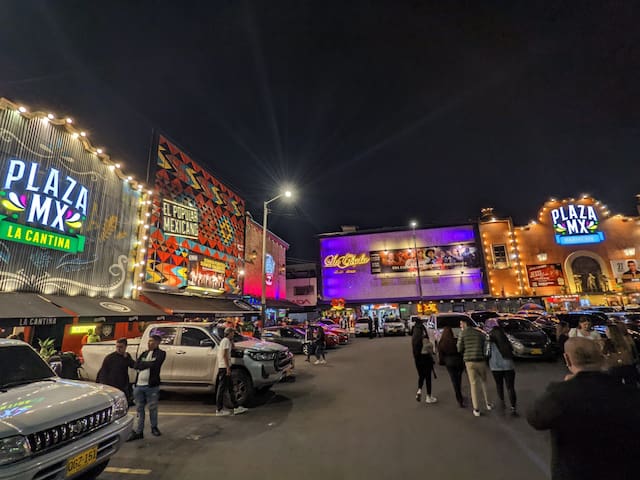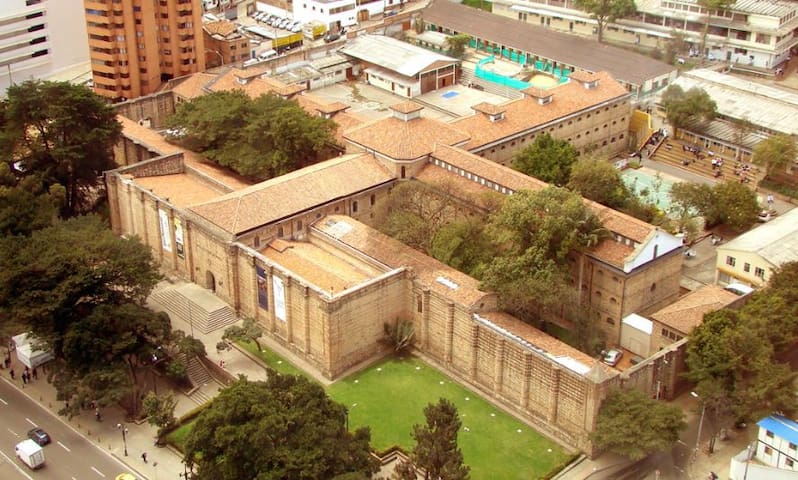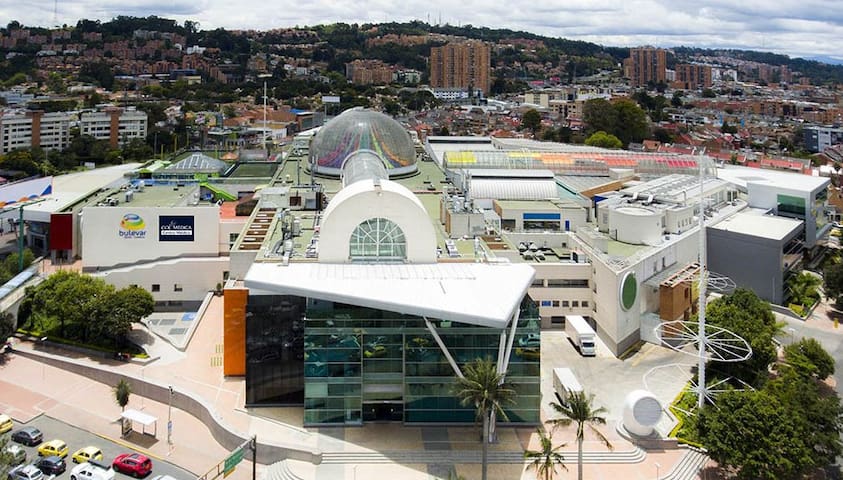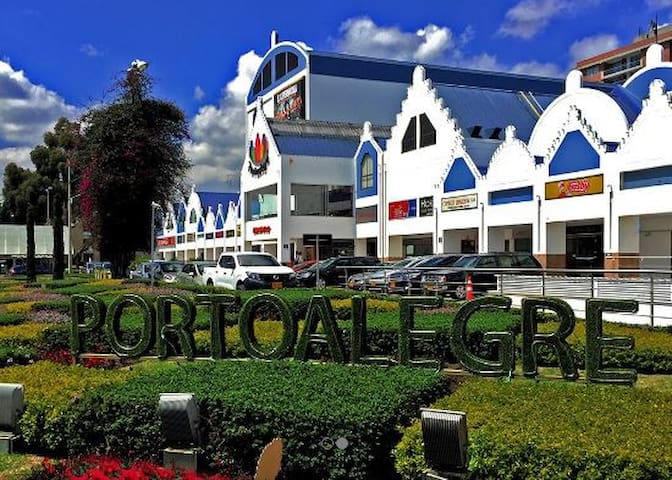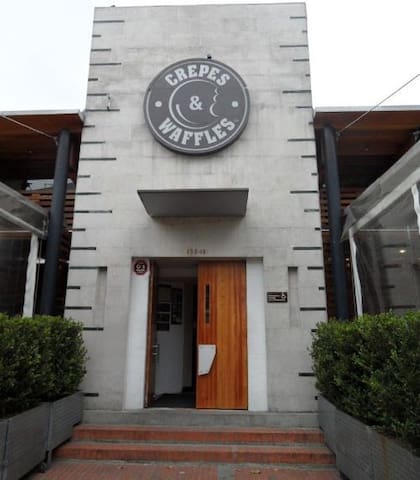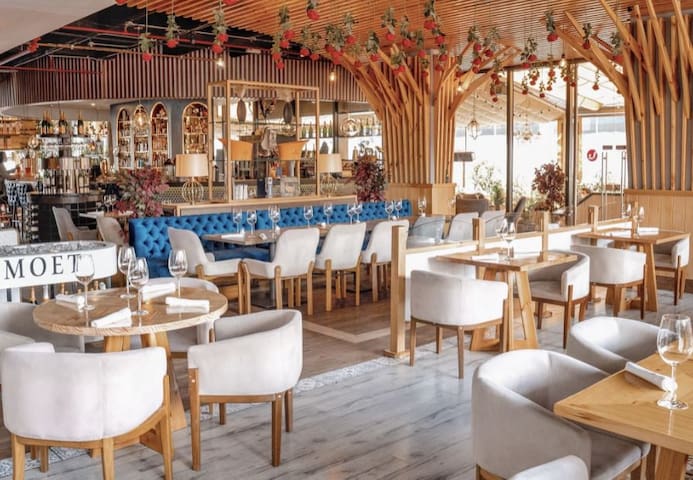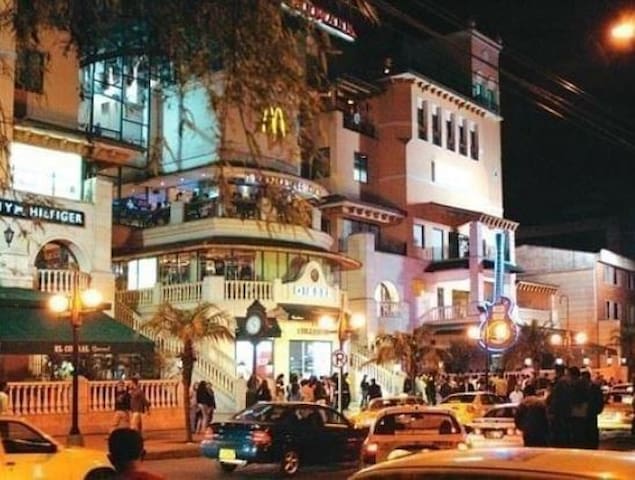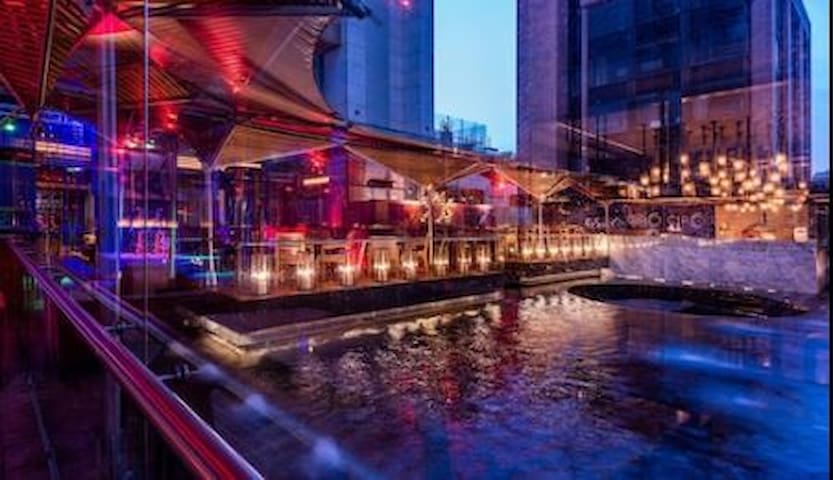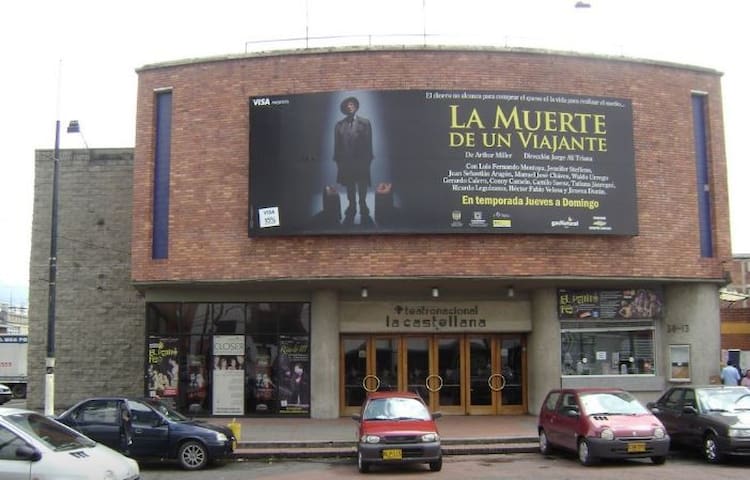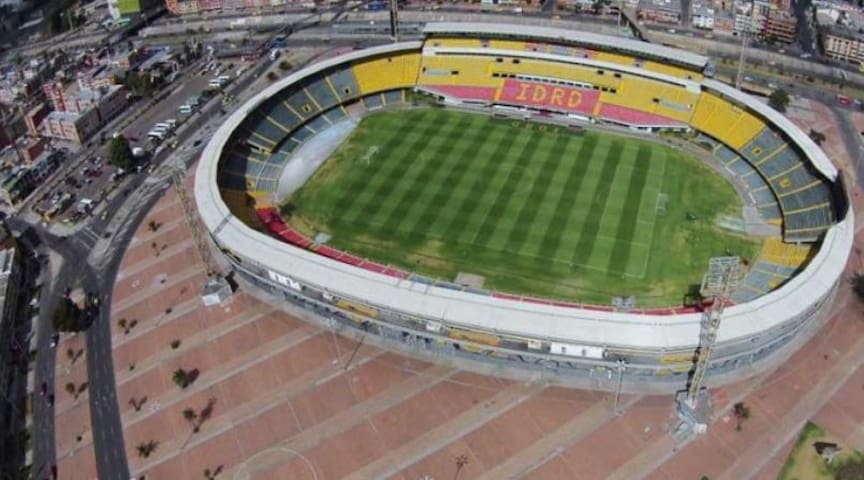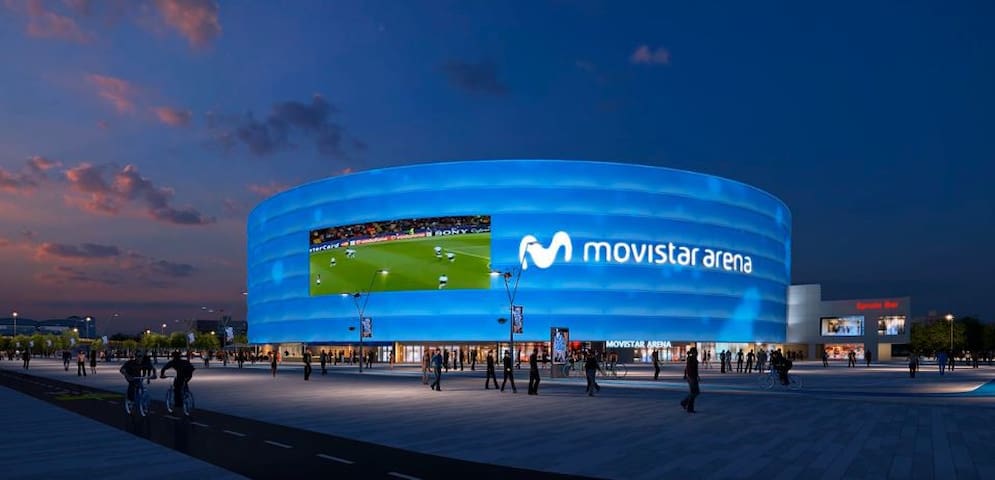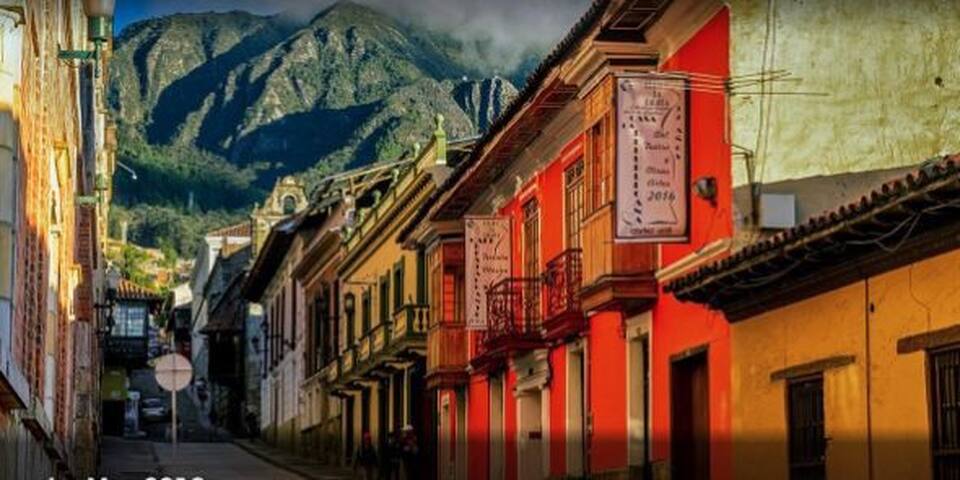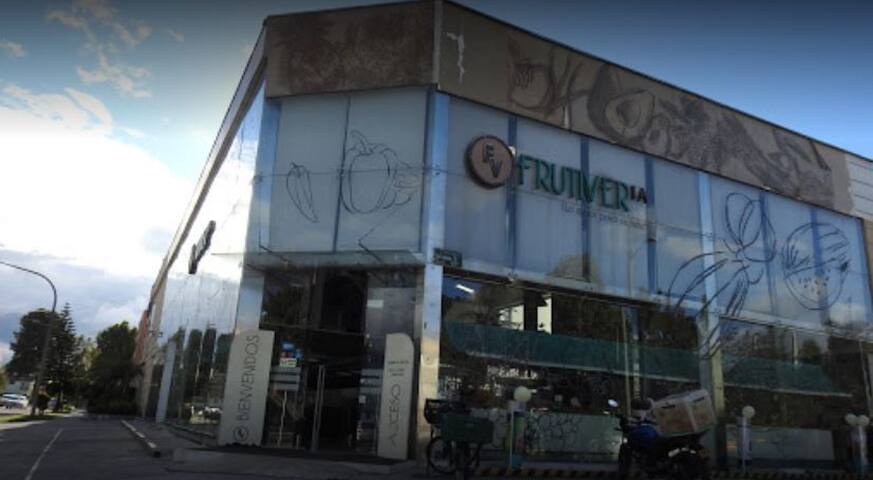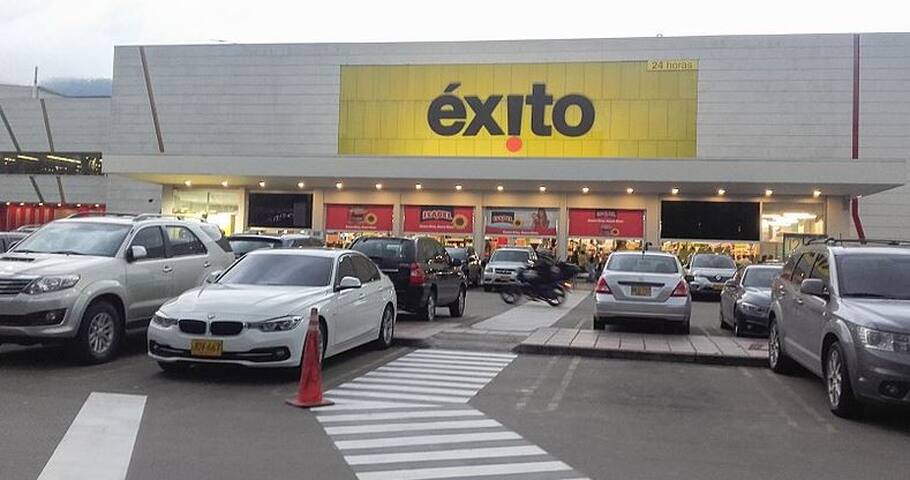Health Services
Clinic Reina Sofia is one of the largest private health service networks in Colombia, constituted by hospitals, outpatient health centers, dental centers and centers specializing in ophthalmology, renal dialysis, and fertility.
Clínica Reina Sofía-AC 127 - KR 20
Clinic Reina Sofia is one of the largest private health service networks in Colombia, constituted by hospitals, outpatient health centers, dental centers and centers specializing in ophthalmology, renal dialysis, and fertility.
Clínica El Bosque
7b-41 Cl. 134Medical Facility
La Fundación Clínica Shaio es el primer centro cardiovascular creado en Colombia, inició labores el 12 de abril de 1957 y desde entonces ha marcado la historia de la cardiología en el país y en el mundo. Nuestros fundadores el Dr. Fernando Valencia Céspedes y el Dr. Alberto Vejarano Laverde iniciaron este gran sueño, gracias a una generosa donación recibida por parte de don Abood Shaio.
Desde el inicio, la Clínica se convirtió en una escuela de cardiología para varios profesionales especializados en el exterior, que encontraron en esta institución un nuevo escenario para aplicar, compartir y crear conocimiento. Hechos importantes de la medicina colombiana ocurrieron por primera vez en la Shaio, por ejemplo el implante del primer marcapasos extracorpóreo, diseñado por el Dr. Jorge Reynolds.
En la actualidad la fundación trabaja para estar a la vanguardia de los últimos avances en tecnología, los cuales unidos a su excelente equipo humano, le permiten brindar respuesta oportuna ante las enfermedades cardiovasculares y de alta complejidad.
Fundación Clínica Shaio-AC 116 - KR 70D
La Fundación Clínica Shaio es el primer centro cardiovascular creado en Colombia, inició labores el 12 de abril de 1957 y desde entonces ha marcado la historia de la cardiología en el país y en el mundo. Nuestros fundadores el Dr. Fernando Valencia Céspedes y el Dr. Alberto Vejarano Laverde iniciaron este gran sueño, gracias a una generosa donación recibida por parte de don Abood Shaio.
Desde el inicio, la Clínica se convirtió en una escuela de cardiología para varios profesionales especializados en el exterior, que encontraron en esta institución un nuevo escenario para aplicar, compartir y crear conocimiento. Hechos importantes de la medicina colombiana ocurrieron por primera vez en la Shaio, por ejemplo el implante del primer marcapasos extracorpóreo, diseñado por el Dr. Jorge Reynolds.
En la actualidad la fundación trabaja para estar a la vanguardia de los últimos avances en tecnología, los cuales unidos a su excelente equipo humano, le permiten brindar respuesta oportuna ante las enfermedades cardiovasculares y de alta complejidad.
Orange Theory Fitness
16-09 Av Calle 116Fitness Center / GYM
Norberto creó fama cuando realizó demostraciones de maquillaje en el desaparecido almacén Sears. Su éxito radica en que fue el primer peluquero del país que supo diversificar el negocio y atender las necesidades particulares de sus clientes. Es así que lo primero que hizo fue mantener la fachada de su casa- edificio simulando las grandes peluquerías francesas. Abrió un espacio para cada rango: tiene una barbería, un lugar ideal para jóvenes y ejecutivos, luego se inauguró un sitio especializado para niños, dotado de tecnologías propias, montajes para la diversión y lúdica, y peluqueros especializados para bebes y niños hasta los 12 años aproximadamente. Finalmente se abrió el spa, un sitio ideal para el relax del cuerpo y el alma.
Norberto lleva más de 20 años participando en el Reinado Nacional de la Belleza; su primer acercamiento lo realizó con la Sta. Tolima y en la actualidad atiende a un sin número de reinas, modelos, personajes de la farándula y la vida nacional.
Ha levantado esta empresa de la mano de su compañero de vida Antonio Lozano. La creación surge de Norberto y la organización empresarial la mantiene Antonio. Norberto ha recibido condecoraciones nacionales e internacionales de las organizaciones más reconocidas en peluquería.
12 íbúar mæla með
Norberto Peluquería
17 A-28 Cl. 109Norberto creó fama cuando realizó demostraciones de maquillaje en el desaparecido almacén Sears. Su éxito radica en que fue el primer peluquero del país que supo diversificar el negocio y atender las necesidades particulares de sus clientes. Es así que lo primero que hizo fue mantener la fachada de su casa- edificio simulando las grandes peluquerías francesas. Abrió un espacio para cada rango: tiene una barbería, un lugar ideal para jóvenes y ejecutivos, luego se inauguró un sitio especializado para niños, dotado de tecnologías propias, montajes para la diversión y lúdica, y peluqueros especializados para bebes y niños hasta los 12 años aproximadamente. Finalmente se abrió el spa, un sitio ideal para el relax del cuerpo y el alma.
Norberto lleva más de 20 años participando en el Reinado Nacional de la Belleza; su primer acercamiento lo realizó con la Sta. Tolima y en la actualidad atiende a un sin número de reinas, modelos, personajes de la farándula y la vida nacional.
Ha levantado esta empresa de la mano de su compañero de vida Antonio Lozano. La creación surge de Norberto y la organización empresarial la mantiene Antonio. Norberto ha recibido condecoraciones nacionales e internacionales de las organizaciones más reconocidas en peluquería.
Hairdresser Martín Vidal Chico Navarra
109a-65 Av. Cra 19Hair Salon
La Calleja Park
127-77 Carrera 20CLÍNICAS JASBAN ODONTOLOGÍA
Bogotá has a center of excellence whose name already reveals royalty. This is Clínica Reina Sofia, which is part of the ColSanitas Group family of health facilities, a network where the medicine of the future is already practiced, with specialized high-tech services always focused on the well-being and health of the patient.
Clínica Reina Sofia has grown with this philosophy since it opened in October 1992. In its more than 25 years of service and patient care, this center of excellence has continued to develop and consolidate processes in the medical, operational and administrative areas, always with the goal of offering high standards of quality and safety, seeking to meet the health needs and expectations of its customers.
This multidisciplinary, personalized and comprehensive approach to care has resulted in Clínica Reina Sofía receiving excellent levels of patient satisfaction, as well as national and international recognition.
Clínica Reina Sofía has 147 hospital beds, including general wards, intensive care wards and neonatal care wards. The patient never feels alone: There are 2 head nurses for every 23 patients and a nurse's aide for every 7.
The center had 10,380 admissions in 2017, and performed 8,570 surgeries. That same year it attended 75,973 emergencies.
Among its many strengths, Clínica Reina Sofia has a leading team in maternal fetal medicine that performs "in uterus" surgeries; highly complex procedures that include tumor removal and intrauterine transfusions in cases of anemia. For its outstanding work, the clinic was recognized as a training center in this medical field.
This unit provides comprehensive care to more than 800 pregnant women per month. And specialized professionals counsel couples with inherited disorders or chronic diseases that can impact the health of the baby.
The World Health Organization has also recognized Clínica Reina Sofia as a Safe Hospital. And patients support this by responding to satisfaction surveys with a score of 4.8/5.
The daily work of the professionals at Clínica Reina Sofía is also reflected in their international accreditations. Since 2008, and as part of the ColSanitas group, it is a member of the International Coalition of the Women's World Summit Foundation, which highlights good patient care as a top priority.
For this reason, and much more, the excellence of this health center transcends the national borders of Colombia. Therefore, every year, the professionals of Clínica Reina Sofia receive hundreds of patients who come from other countries to perform treatments or complex surgeries. And as soon as they arrive, they feel at home.
The professionals of the clinic receive them at the airport, and completely coordinate everything: From the necessary migratory procedures, to the transfers, the lodging prior to the hospitalization of the patient, and of the family. And, also the follow-up, even when the patient returns to his country of origin.
For the clinic staff, the mission has been fulfilled once again, when the patient is healthy and happy.
25 íbúar mæla með
Clínica Reina Sofía
20-78 Cl 127Bogotá has a center of excellence whose name already reveals royalty. This is Clínica Reina Sofia, which is part of the ColSanitas Group family of health facilities, a network where the medicine of the future is already practiced, with specialized high-tech services always focused on the well-being and health of the patient.
Clínica Reina Sofia has grown with this philosophy since it opened in October 1992. In its more than 25 years of service and patient care, this center of excellence has continued to develop and consolidate processes in the medical, operational and administrative areas, always with the goal of offering high standards of quality and safety, seeking to meet the health needs and expectations of its customers.
This multidisciplinary, personalized and comprehensive approach to care has resulted in Clínica Reina Sofía receiving excellent levels of patient satisfaction, as well as national and international recognition.
Clínica Reina Sofía has 147 hospital beds, including general wards, intensive care wards and neonatal care wards. The patient never feels alone: There are 2 head nurses for every 23 patients and a nurse's aide for every 7.
The center had 10,380 admissions in 2017, and performed 8,570 surgeries. That same year it attended 75,973 emergencies.
Among its many strengths, Clínica Reina Sofia has a leading team in maternal fetal medicine that performs "in uterus" surgeries; highly complex procedures that include tumor removal and intrauterine transfusions in cases of anemia. For its outstanding work, the clinic was recognized as a training center in this medical field.
This unit provides comprehensive care to more than 800 pregnant women per month. And specialized professionals counsel couples with inherited disorders or chronic diseases that can impact the health of the baby.
The World Health Organization has also recognized Clínica Reina Sofia as a Safe Hospital. And patients support this by responding to satisfaction surveys with a score of 4.8/5.
The daily work of the professionals at Clínica Reina Sofía is also reflected in their international accreditations. Since 2008, and as part of the ColSanitas group, it is a member of the International Coalition of the Women's World Summit Foundation, which highlights good patient care as a top priority.
For this reason, and much more, the excellence of this health center transcends the national borders of Colombia. Therefore, every year, the professionals of Clínica Reina Sofia receive hundreds of patients who come from other countries to perform treatments or complex surgeries. And as soon as they arrive, they feel at home.
The professionals of the clinic receive them at the airport, and completely coordinate everything: From the necessary migratory procedures, to the transfers, the lodging prior to the hospitalization of the patient, and of the family. And, also the follow-up, even when the patient returns to his country of origin.
For the clinic staff, the mission has been fulfilled once again, when the patient is healthy and happy.
Clínica Pediátrica, inaugurada el 7 de Julio de 2016, presta servicios ambulatorios y hospitalarios especialmente a la población infantil; es la empresa del Grupo Empresarial Keralty encargada de la atención y desarrollo en la infraestructura clínica y hospitalaria, de centros médicos, laboratorios clínicos, centros odontológicos, centros ópticos y centros oftalmológicos en Colombia, le apuesta a un modelo de salud centrado en la persona, el cual propone metodologías y procesos que van más allá de lo netamente asistencial porque entiende el respeto a las necesidades integrales y preferencias de las personas. Acompañamos a las personas durante toda su vida, estamos al lado de ellas desde antes de nacer hasta el duelo de los familiares en el momento en el que fallecen. Esto hace que nuestros usuarios confíen en nuestra institución y en nuestro equipo humano cálido, compasivo, respetuoso e idóneo.
Pediatric Clinic Colsanitas
20-56 Avenida Calle 127Clínica Pediátrica, inaugurada el 7 de Julio de 2016, presta servicios ambulatorios y hospitalarios especialmente a la población infantil; es la empresa del Grupo Empresarial Keralty encargada de la atención y desarrollo en la infraestructura clínica y hospitalaria, de centros médicos, laboratorios clínicos, centros odontológicos, centros ópticos y centros oftalmológicos en Colombia, le apuesta a un modelo de salud centrado en la persona, el cual propone metodologías y procesos que van más allá de lo netamente asistencial porque entiende el respeto a las necesidades integrales y preferencias de las personas. Acompañamos a las personas durante toda su vida, estamos al lado de ellas desde antes de nacer hasta el duelo de los familiares en el momento en el que fallecen. Esto hace que nuestros usuarios confíen en nuestra institución y en nuestro equipo humano cálido, compasivo, respetuoso e idóneo.
Centro de tratamiento e investigación sobre Cáncer Luis Carlos Sarmiento Angulo
Sightseeing
On the north side of town near the country club set, Unicentro Shopping Mall carries international products and has a diverse food court, bowling, cinema and a 24/7 Exito discount/supermarket. Built in the 1970s, it is the oldest mall in the city but regularly updated.
Unicentro Shopping Mall
30 Cra. 15On the north side of town near the country club set, Unicentro Shopping Mall carries international products and has a diverse food court, bowling, cinema and a 24/7 Exito discount/supermarket. Built in the 1970s, it is the oldest mall in the city but regularly updated.
Its charm is nature, and not only because of the beautiful and well-kept recreation and sports fields, but because it tries to carry out an ecological program based on a poultry sighting and planting different tree species. This beautiful complex has: an 18 hole golf course; 24 tennis courts; a pool of 6 lanes of 25 meters; an equestrian track for vaulting and 4 mangers; a professional natural grass soccer field; 3 squash courts, and a gym that gives you physical assessment and different classes. It also has 6 dining rooms, 4 sports shelters and four rooms for social and business events.
Country Club
Country ClubIts charm is nature, and not only because of the beautiful and well-kept recreation and sports fields, but because it tries to carry out an ecological program based on a poultry sighting and planting different tree species. This beautiful complex has: an 18 hole golf course; 24 tennis courts; a pool of 6 lanes of 25 meters; an equestrian track for vaulting and 4 mangers; a professional natural grass soccer field; 3 squash courts, and a gym that gives you physical assessment and different classes. It also has 6 dining rooms, 4 sports shelters and four rooms for social and business events.
Hacienda Santa Bárbara, an upscale mall built around a colonial hacienda, has cobblestone squares, fountains, stone paths and the flavor of a small Colombian village. Built in 1989, it is popular with both locals and tourists with more than 350 shops on three levels, restaurants, coffee shops, live music and cinema.
The Hacienda Santa Barbara is also a great place to go for shopping or having some beers with Colombian Empanadas while you watch a soccer game!
Hacienda Is also located next to Usaquen, a little spanish colonial style town that you will love!
You need to go there if you visit Bogota!!! They have a street market with wonderful pieces of art!!
139 íbúar mæla með
Hacienda Santa Barbara
115-60 Ak. 7Hacienda Santa Bárbara, an upscale mall built around a colonial hacienda, has cobblestone squares, fountains, stone paths and the flavor of a small Colombian village. Built in 1989, it is popular with both locals and tourists with more than 350 shops on three levels, restaurants, coffee shops, live music and cinema.
The Hacienda Santa Barbara is also a great place to go for shopping or having some beers with Colombian Empanadas while you watch a soccer game!
Hacienda Is also located next to Usaquen, a little spanish colonial style town that you will love!
You need to go there if you visit Bogota!!! They have a street market with wonderful pieces of art!!
Commonly known as Parque de la 93) is a commercial and recreational park located at the 93rd Street (calle 93) in El Chicó, in the north of Bogota, Colombia. Is one of Bogota's most popular shopping, night club and restaurant areas.
In the beginning of the 21st century, the park became the most popular park in the north of Bogota, where public venues as entertainment, publicly viewed football matches were shown. The park also hosts temporary expositions. With Christmas, the park is decorated with lighting and a large Christmas tree is erected in the park.
The most notable are the restaurants around the park, as Café Renault, Gato Negro, Juan Valdez café, the beautiful gardens, and design centers and nightclubs in the surrounding area.
At the western park edge, Colombia's first Starbucks was opened in 2015.
The park is a center of nightlife in Bogota, located in the district of Chapinero where clubs, restaurants, shops, art galleries, auctions, design centers are abundant.
The park can be accessed from the main Carreras 11 and 15.
486 íbúar mæla með
Park 93
11A-41 Cl. 93Commonly known as Parque de la 93) is a commercial and recreational park located at the 93rd Street (calle 93) in El Chicó, in the north of Bogota, Colombia. Is one of Bogota's most popular shopping, night club and restaurant areas.
In the beginning of the 21st century, the park became the most popular park in the north of Bogota, where public venues as entertainment, publicly viewed football matches were shown. The park also hosts temporary expositions. With Christmas, the park is decorated with lighting and a large Christmas tree is erected in the park.
The most notable are the restaurants around the park, as Café Renault, Gato Negro, Juan Valdez café, the beautiful gardens, and design centers and nightclubs in the surrounding area.
At the western park edge, Colombia's first Starbucks was opened in 2015.
The park is a center of nightlife in Bogota, located in the district of Chapinero where clubs, restaurants, shops, art galleries, auctions, design centers are abundant.
The park can be accessed from the main Carreras 11 and 15.
Museo del Chicó is also known as Mercedes Sierra de Pérez Museum, and it is both a park and a museum that can be found over in the el Chicó neighborhood that is located just north of Bogotá. In 1911, this land and house were inherited by the historical Sierra family and subsequently donated it to the community along with money so that it could be turned into a museum that locals and tourists could enjoy through the years along with lands of 116th Street or Pepe Sierra Avenue. It was first declared a cultural landmark back in the year 1992 but it has been a museum since 1964. It’s found between Carreras 7 and 9 in the town of Chapinero. There is a colonial house found within the park that has amazing gardens and trees surrounding it which was built all the way back in 1500! For these reasons, it is easy to see why history bluffs consider this a must-see destination for those who happen to be visiting Bogotá. You get an accurate depiction of what it was like back in that day, much like stepping into your very own time machine.
Not only is Museo del Chicó a museum, but the large park surrounding it is perfect for lounging around and having a picnic with family or friends, and there are various activities to consider taking part in. This is an extremely popular destination when the weather is nice, and it is easy to see why that is. The playground in the garden area has been here since 1964 and has made a lot of children happy in the meantime! You can also find a children’s library on site that has activities for children like arts and crafts and storytime. This is why this is such an acceptable destination for families to check out because there is a little something that each person can certainly enjoy.
Separate from that, there are rooms for rent which would be absolutely perfect for a memorable party venue. There are also temporary exhibitions that change throughout the year, so there is always something to enjoy whenever you decide to visit this tourist attraction near Bogotá. There are even more activities such as horse riding, skating areas, and bicycle rental. Stop and enjoy the scenery at the laguito (or pond) which can be found in the upper area of the park, or simply stroll through the gardens for stress relief. It’s completely up to you! It’s very interesting to see a house as people in the past would have lived in it. That’s only part of the charm of this tourist destination in Bogotá. There is an English double-decker bus that has been repurposed into a cafe which is totally fun to experience.
Museo del Chicó houses a gorgeous chapel and extremely detailed tile work and woodwork throughout the house here. In fact, most of the original stonework and fencing still exist throughout the grounds here. They have done a great job of making sure everything is intact and preserved for future generations to enjoy. The museum holds a collection of objects that Mrs. Mercedes created while traveling across multiple continents along with collections of porcelain, glassware, and decorative art items. If you do want to hold a social event here such as a wedding or birthday party, there are three different areas to choose from. There is La Casona, which holds 180 people, La Casa del Parque which holds 100 people, and the Sede Junio room which holds 70 people.
How to Get There
You can embark on a local tour with a guide company, but you don’t have to do that! You can easily reach this destination using public transportation as well. It is just a short walk from Parque 93, so why not make a day out of viewing this safe area of Bogotá?
Admission
Admission into the museum is 7.000 COP in the general public, 5.000 COP for students, children, and seniors, children under 5 years of age get free admission. Books can be rented from the children’s library for around 25.000 COP. The museum on Tuesday through Sunday from 10:00 am. to 1:00 pm. and from 2:00 pm. to 4:30 pm. Mondays and Holidays are closed. Keep in mind this schedule when you’re planning a visit to Museo del Chicó.
Tips
If you need to get in touch with the staff at the venue, you can email them at info@museodelchico.com or give them a call at 57 1 6231066 extension 221.
This is found within an upscale neighborhood of Bogotá, so you will not have to worry about your safety whenever you do decide to visit this destination.
From September to October, there are a lot of events happening here put on by a local beer company and supermarket.
It only takes about an hour or less to go through the entire museum.
The crowds aren’t ever particularly busy or large here besides Sundays, so it is a great destination for those to consider who don’t enjoy the hustle and bustle of busy tourist destinations.
There is a short introductory film that is optional to watch before going through the museum. We recommend staying to watch the film so that you can get the full experience.
There is a tiny gift shop with limited items, so try to remember to bring cash along with you in case there is something that catches your eye inside.
Museo del Chicó
Museo del ChicóMuseo del Chicó is also known as Mercedes Sierra de Pérez Museum, and it is both a park and a museum that can be found over in the el Chicó neighborhood that is located just north of Bogotá. In 1911, this land and house were inherited by the historical Sierra family and subsequently donated it to the community along with money so that it could be turned into a museum that locals and tourists could enjoy through the years along with lands of 116th Street or Pepe Sierra Avenue. It was first declared a cultural landmark back in the year 1992 but it has been a museum since 1964. It’s found between Carreras 7 and 9 in the town of Chapinero. There is a colonial house found within the park that has amazing gardens and trees surrounding it which was built all the way back in 1500! For these reasons, it is easy to see why history bluffs consider this a must-see destination for those who happen to be visiting Bogotá. You get an accurate depiction of what it was like back in that day, much like stepping into your very own time machine.
Not only is Museo del Chicó a museum, but the large park surrounding it is perfect for lounging around and having a picnic with family or friends, and there are various activities to consider taking part in. This is an extremely popular destination when the weather is nice, and it is easy to see why that is. The playground in the garden area has been here since 1964 and has made a lot of children happy in the meantime! You can also find a children’s library on site that has activities for children like arts and crafts and storytime. This is why this is such an acceptable destination for families to check out because there is a little something that each person can certainly enjoy.
Separate from that, there are rooms for rent which would be absolutely perfect for a memorable party venue. There are also temporary exhibitions that change throughout the year, so there is always something to enjoy whenever you decide to visit this tourist attraction near Bogotá. There are even more activities such as horse riding, skating areas, and bicycle rental. Stop and enjoy the scenery at the laguito (or pond) which can be found in the upper area of the park, or simply stroll through the gardens for stress relief. It’s completely up to you! It’s very interesting to see a house as people in the past would have lived in it. That’s only part of the charm of this tourist destination in Bogotá. There is an English double-decker bus that has been repurposed into a cafe which is totally fun to experience.
Museo del Chicó houses a gorgeous chapel and extremely detailed tile work and woodwork throughout the house here. In fact, most of the original stonework and fencing still exist throughout the grounds here. They have done a great job of making sure everything is intact and preserved for future generations to enjoy. The museum holds a collection of objects that Mrs. Mercedes created while traveling across multiple continents along with collections of porcelain, glassware, and decorative art items. If you do want to hold a social event here such as a wedding or birthday party, there are three different areas to choose from. There is La Casona, which holds 180 people, La Casa del Parque which holds 100 people, and the Sede Junio room which holds 70 people.
How to Get There
You can embark on a local tour with a guide company, but you don’t have to do that! You can easily reach this destination using public transportation as well. It is just a short walk from Parque 93, so why not make a day out of viewing this safe area of Bogotá?
Admission
Admission into the museum is 7.000 COP in the general public, 5.000 COP for students, children, and seniors, children under 5 years of age get free admission. Books can be rented from the children’s library for around 25.000 COP. The museum on Tuesday through Sunday from 10:00 am. to 1:00 pm. and from 2:00 pm. to 4:30 pm. Mondays and Holidays are closed. Keep in mind this schedule when you’re planning a visit to Museo del Chicó.
Tips
If you need to get in touch with the staff at the venue, you can email them at info@museodelchico.com or give them a call at 57 1 6231066 extension 221.
This is found within an upscale neighborhood of Bogotá, so you will not have to worry about your safety whenever you do decide to visit this destination.
From September to October, there are a lot of events happening here put on by a local beer company and supermarket.
It only takes about an hour or less to go through the entire museum.
The crowds aren’t ever particularly busy or large here besides Sundays, so it is a great destination for those to consider who don’t enjoy the hustle and bustle of busy tourist destinations.
There is a short introductory film that is optional to watch before going through the museum. We recommend staying to watch the film so that you can get the full experience.
There is a tiny gift shop with limited items, so try to remember to bring cash along with you in case there is something that catches your eye inside.
Andino Mall is the heart of one of the favorites by the citizens and foreign areas, and is recognized as the most exclusive mall in the city. The privileged location, ambience, comfort, safety, excellent service and wide range of shops recognized nationally and internationally, make it the best choice for your shopping and entertainment. It has 230 shops spread over 4 levels, 700 parking spaces located in two basement with valet parking and exclusive services for children and adults.
This mall has a Louis Vuitton, Tiffany & Co., Montblanc, Dolce & Gabanna and Oscar de la Renta.
527 íbúar mæla með
Andino verslunarmiðstöð
82-71 Cra. 11Andino Mall is the heart of one of the favorites by the citizens and foreign areas, and is recognized as the most exclusive mall in the city. The privileged location, ambience, comfort, safety, excellent service and wide range of shops recognized nationally and internationally, make it the best choice for your shopping and entertainment. It has 230 shops spread over 4 levels, 700 parking spaces located in two basement with valet parking and exclusive services for children and adults.
This mall has a Louis Vuitton, Tiffany & Co., Montblanc, Dolce & Gabanna and Oscar de la Renta.
The José Celestino Mutis botanical garden is Colombia's biggest botanical garden. It serves both as a recreation and research center with an emphasis on Andean and Páramo ecosystems. The garden is located in Bogotá and features plants from every Colombian altitude, climate and region. It was founded in 1955, in honor of botanist and astronomer José Celestino Mutis.
The municipally owned park is famous nationwide and is a member of the internationally known BGCI (Botanic Gardens Conservation International). The garden has an artificial waterfall and labs for studying plants and flowers. It also has public services such as a library and a tourist information desk. The garden is the only one in the nation specialized in preserving and collecting Andean species of flowers. Its 19.5 acres are full with collections of plants grouped by their original ecosystem.
Among other curiosities, the park includes a sun clock, a palmetum, an orchid collection, and a wide variety of Amazon flowers.
68 íbúar mæla með
Jardín Botánico
The José Celestino Mutis botanical garden is Colombia's biggest botanical garden. It serves both as a recreation and research center with an emphasis on Andean and Páramo ecosystems. The garden is located in Bogotá and features plants from every Colombian altitude, climate and region. It was founded in 1955, in honor of botanist and astronomer José Celestino Mutis.
The municipally owned park is famous nationwide and is a member of the internationally known BGCI (Botanic Gardens Conservation International). The garden has an artificial waterfall and labs for studying plants and flowers. It also has public services such as a library and a tourist information desk. The garden is the only one in the nation specialized in preserving and collecting Andean species of flowers. Its 19.5 acres are full with collections of plants grouped by their original ecosystem.
Among other curiosities, the park includes a sun clock, a palmetum, an orchid collection, and a wide variety of Amazon flowers.
Chose the place to found Santa Fe, he was struck by the two huge hills that surrounded the plain. Taking advantage of the mystery and the majestic presence of those hills, he placed two large crosses at its top. A century later, Don Juan de Borja, President of the New Kingdom of Granada, authorized Don Pedro Solis de Valenzuela in 1640 to build a chapel dedicated to the Virgin Morena de Montserrat, whose Sanctuary is located in the province of Barcelona in Spain.
Don Pedro Solis, architect of this work, didn’t want it to end there, he knew that the place was ideal for a monastery, which was finally built in 1657 with the help of the Santaferenos. Years later he would accommodate his most illustrious guest: the Fallen Lord of Monserrate, work of the Santaferian master Pedro de Lugo and Albarracín who achieved not only a beautiful image of impressive artistic value , but also managed to gather the religious faith of the city.
Since that time, every day, thousands of believers climb with devotion the steps that lead to the Sanctuary at the top as a penitence. While thousands of other tourists, athletes or curious people arrive by foot, in Funicular or Cable Car.
The view of Bogota from Monserrate, the faith evoked by its Sanctuary, its pilgrims, its gardens and fountains, its gastronomy, its fog forests, its sunsets, its starry nights and its majestic moon, make visiting Monserrate hill a unique experience.
https://monserrate.co/en/monserrate-hill/
33 íbúar mæla með
Monserrate helgidómurinn
Chose the place to found Santa Fe, he was struck by the two huge hills that surrounded the plain. Taking advantage of the mystery and the majestic presence of those hills, he placed two large crosses at its top. A century later, Don Juan de Borja, President of the New Kingdom of Granada, authorized Don Pedro Solis de Valenzuela in 1640 to build a chapel dedicated to the Virgin Morena de Montserrat, whose Sanctuary is located in the province of Barcelona in Spain.
Don Pedro Solis, architect of this work, didn’t want it to end there, he knew that the place was ideal for a monastery, which was finally built in 1657 with the help of the Santaferenos. Years later he would accommodate his most illustrious guest: the Fallen Lord of Monserrate, work of the Santaferian master Pedro de Lugo and Albarracín who achieved not only a beautiful image of impressive artistic value , but also managed to gather the religious faith of the city.
Since that time, every day, thousands of believers climb with devotion the steps that lead to the Sanctuary at the top as a penitence. While thousands of other tourists, athletes or curious people arrive by foot, in Funicular or Cable Car.
The view of Bogota from Monserrate, the faith evoked by its Sanctuary, its pilgrims, its gardens and fountains, its gastronomy, its fog forests, its sunsets, its starry nights and its majestic moon, make visiting Monserrate hill a unique experience.
https://monserrate.co/en/monserrate-hill/
Chorro de Quevedo (Quevedo's fountain) is a fountain located in the neighborhood of La Candelaria in Bogotá. It signifies the purported location were Gonzalo Jiménez de Quesada, a Spanish conquistador, first established the foundations of Bogotá in 1538. Also, it is considered the place where the Zipa, or chief of the Muisca tribe, would regularly survey the Bogotá savanna. In 1832, an Augustine priest named Father Quevedo purchased the site and built a fountain there. The original fountain was destroyed in 1896, due to pipe damage from a collapsing bridge. It is located above Calle 13 and Carrera 2.
In the plaza, there is a small white chapel called the Hermitage of San Miguel del Principe that was built in 1969 on the site of the very first chapel in Bogotá. It is based on a reconstruction of a church that was once in Santander Plaza but razed because the external appearance was too plain. The church steps and the nearby arch was built by Javier Olave to recognize the local "lunatics": Bobo del Tranvía, the Conde Cuchute, the Loca Margarita.
Several films have been shot at this location, including La estrategia del caracol and Diástole y sístole. These films reflect the bohemian subculture of the area. There are narrow alleyways nearby that have artist studios and hostels. Colorful street art can be found on nearby walls. There are also local establishments nearby that serve chicha.
In the square, public storytellers can be found.
This is the oldest site in all of the Candelaria and Bogota, for it was here that the first houses of the city were constructed.
The famous Chorro de Quevedo (Quevedo’s Stream), which is recent years has been converted in one of the must-see touristic sites of Bogota. The site consists of a little square and a narrow street called La Calle del Embudo (Bottleneck Street). This street is picturesque and one can stroll this street while appreciating the various handcrafts and different paintings on the walls of the old houses, which today have been converted into bars and artisanal shops.
As a recommendation for when you visit this fun spot (because you will see that it’s entertaining), don’t forget to ask for “La Bendita” (The Blessed), the Museum of la Chicha, which is decorated by typical antiquities of Bogota where you can mash corn and learn a little about the history of Bogota and, of course, drink the ancestral drink of the region, chicha.
139 íbúar mæla með
Plazoleta Chorro de Quevedo
22 Cl. 12bChorro de Quevedo (Quevedo's fountain) is a fountain located in the neighborhood of La Candelaria in Bogotá. It signifies the purported location were Gonzalo Jiménez de Quesada, a Spanish conquistador, first established the foundations of Bogotá in 1538. Also, it is considered the place where the Zipa, or chief of the Muisca tribe, would regularly survey the Bogotá savanna. In 1832, an Augustine priest named Father Quevedo purchased the site and built a fountain there. The original fountain was destroyed in 1896, due to pipe damage from a collapsing bridge. It is located above Calle 13 and Carrera 2.
In the plaza, there is a small white chapel called the Hermitage of San Miguel del Principe that was built in 1969 on the site of the very first chapel in Bogotá. It is based on a reconstruction of a church that was once in Santander Plaza but razed because the external appearance was too plain. The church steps and the nearby arch was built by Javier Olave to recognize the local "lunatics": Bobo del Tranvía, the Conde Cuchute, the Loca Margarita.
Several films have been shot at this location, including La estrategia del caracol and Diástole y sístole. These films reflect the bohemian subculture of the area. There are narrow alleyways nearby that have artist studios and hostels. Colorful street art can be found on nearby walls. There are also local establishments nearby that serve chicha.
In the square, public storytellers can be found.
This is the oldest site in all of the Candelaria and Bogota, for it was here that the first houses of the city were constructed.
The famous Chorro de Quevedo (Quevedo’s Stream), which is recent years has been converted in one of the must-see touristic sites of Bogota. The site consists of a little square and a narrow street called La Calle del Embudo (Bottleneck Street). This street is picturesque and one can stroll this street while appreciating the various handcrafts and different paintings on the walls of the old houses, which today have been converted into bars and artisanal shops.
As a recommendation for when you visit this fun spot (because you will see that it’s entertaining), don’t forget to ask for “La Bendita” (The Blessed), the Museum of la Chicha, which is decorated by typical antiquities of Bogota where you can mash corn and learn a little about the history of Bogota and, of course, drink the ancestral drink of the region, chicha.
Bolívar Square has been at the center of the country's history for centuries. It used to be a public circus and bull market, among other things, and a wide variety of cultural and social events are still held here. Buildings such as the Palacio Liévano, the Capitol, and the Cathedral frame this public space, which is decorated with thousands of colorful lights every year for Christmas.
La Plaza de Bolívar proudly bears the name of the liberator of Colombia. In the center of the square one can see a statue of the eponymous Simón Bolívar, which was donated by the Italian artist Pietro Tenerani in the year 1846. This square originally was an enormous market square surrounded by colonial houses. Today it is encircled by the Office of the Mayor of Bogota, the Palace of Justice, and the Chapel of the Tabernacle, among other buildings of civil importance for the city.
363 íbúar mæla með
Bolivar torg
11-10 Cra. 7Bolívar Square has been at the center of the country's history for centuries. It used to be a public circus and bull market, among other things, and a wide variety of cultural and social events are still held here. Buildings such as the Palacio Liévano, the Capitol, and the Cathedral frame this public space, which is decorated with thousands of colorful lights every year for Christmas.
La Plaza de Bolívar proudly bears the name of the liberator of Colombia. In the center of the square one can see a statue of the eponymous Simón Bolívar, which was donated by the Italian artist Pietro Tenerani in the year 1846. This square originally was an enormous market square surrounded by colonial houses. Today it is encircled by the Office of the Mayor of Bogota, the Palace of Justice, and the Chapel of the Tabernacle, among other buildings of civil importance for the city.
In La Candelaria, the historical center of Bogotá, you can visit the Luis Angel Arango Library, the largest in Colombia and one of the busiest in the world, with nearly 5,000 daily visitors. It was inaugurated on February 20, 1958 and named after Luis Angel Arango, who was the general manager of the Bank of the Republic between 1947 and 1957.
94 íbúar mæla með
Bókasafn Luis Angel Arango
4-14 Cl. 11In La Candelaria, the historical center of Bogotá, you can visit the Luis Angel Arango Library, the largest in Colombia and one of the busiest in the world, with nearly 5,000 daily visitors. It was inaugurated on February 20, 1958 and named after Luis Angel Arango, who was the general manager of the Bank of the Republic between 1947 and 1957.
The García Márquez Cultural Center is a place to enjoy art and culture in their multiple forms of expression.
This site offers a library, which has enough room to for 50,000 books, and an art gallery with 216 square meters of exhibition space. What’s more, it is home to other spaces in which one can enjoy concerts, book presentations and various other events. This is an attractive spot if you enjoy art and culture.
Among the most appealing touristic attractions of Bogota that are close to La Candelaria, we find the Gold Museum (El Museo del Oro) and Monserrate Peak, both of which you can walk to from the historical Old Town (La Candelaria).
50 íbúar mæla með
Menningar Miðstöð Gabriel Garcia Marquez
##5-60 Cl. 11The García Márquez Cultural Center is a place to enjoy art and culture in their multiple forms of expression.
This site offers a library, which has enough room to for 50,000 books, and an art gallery with 216 square meters of exhibition space. What’s more, it is home to other spaces in which one can enjoy concerts, book presentations and various other events. This is an attractive spot if you enjoy art and culture.
Among the most appealing touristic attractions of Bogota that are close to La Candelaria, we find the Gold Museum (El Museo del Oro) and Monserrate Peak, both of which you can walk to from the historical Old Town (La Candelaria).
The international business and exhibition center – CORFERIAS -
A private company which fosters industrial, social, cultural and commercial development in the Andean region, Central America and the Caribbean. Our major shareholder is the Bogota Chamber of Commerce, which represents the interests of the business community and society in general.
CORFERIAS has more than 65 years experience, and seeks to strengthen its ties of cooperation between Colombia and the world community through the organisation of fairs, exhibitions, events and conventions, encouraging the generation of meaningful contacts between visitors and exhibitors as a venue with full biosecurity procedures, or on digital platforms operating to international standards.
Corferias-AK 40 - CL 24C
The international business and exhibition center – CORFERIAS -
A private company which fosters industrial, social, cultural and commercial development in the Andean region, Central America and the Caribbean. Our major shareholder is the Bogota Chamber of Commerce, which represents the interests of the business community and society in general.
CORFERIAS has more than 65 years experience, and seeks to strengthen its ties of cooperation between Colombia and the world community through the organisation of fairs, exhibitions, events and conventions, encouraging the generation of meaningful contacts between visitors and exhibitors as a venue with full biosecurity procedures, or on digital platforms operating to international standards.
Casino Rio
122-64 Avenida 19Gambling Casino
If you are in the mood for a memorable evening out, either by yourself or with some friends, then La Chula is the place to be. Known for hosting live music performances and events, La Chula will not disappoint whether you are a fan of Mariachi music, wish to listen to some Latin music or simply do some Meringue, then you are at the right place. Patrons can also spend their time downing the delicious cocktails while enjoying the relaxed vibe of the place or dig into hearty Mexican food. Irrespective of what you decide to do, a great time at La Chula is guaranteed.
http://lachula.com.co/
14 íbúar mæla með
The Chula Bar
19-50 Avenida Calle 116If you are in the mood for a memorable evening out, either by yourself or with some friends, then La Chula is the place to be. Known for hosting live music performances and events, La Chula will not disappoint whether you are a fan of Mariachi music, wish to listen to some Latin music or simply do some Meringue, then you are at the right place. Patrons can also spend their time downing the delicious cocktails while enjoying the relaxed vibe of the place or dig into hearty Mexican food. Irrespective of what you decide to do, a great time at La Chula is guaranteed.
http://lachula.com.co/
The National Museum of Colombia has built a collection of more than 20,000 objects that are symbols of national history and heritage. The collections include remains of the first inhabitants and material culture of prehispanic societies, objects from current indigenous and afrocolombian ethnography, evidence of different periods of the nation's history, and works of art that range from the colonial period through the works of 'the first modern' artists: Fernando Botero, Alejandro Obregón, Guillermo Wiedemann, Juan Antonio Roda, Eduardo Ramírez Villamizar, Edgar Negret and Enrique Grau.
The Museum offers permanent exhibition galleries with more than 2,500 pieces currently on display, a calendar of temporary exhibitions that allows its visitors to be in touch with important national and international displays of history, art and archaeology, and a varied educational and cultural program that includes seminars, lectures, concerts, video, theatrical and dance performances.
As a contribution to academic discussions on Colombia´s cultural history, the Museum organizes the Cátedra Anual de Historia 'Ernesto Restrepo Tirado', an academic event that has been carried out annually for more than 10 years. It also offers a series of publications that compile material on the Museum's collections as well as the memoirs of academic events.
370 íbúar mæla með
Museo Nacional
The National Museum of Colombia has built a collection of more than 20,000 objects that are symbols of national history and heritage. The collections include remains of the first inhabitants and material culture of prehispanic societies, objects from current indigenous and afrocolombian ethnography, evidence of different periods of the nation's history, and works of art that range from the colonial period through the works of 'the first modern' artists: Fernando Botero, Alejandro Obregón, Guillermo Wiedemann, Juan Antonio Roda, Eduardo Ramírez Villamizar, Edgar Negret and Enrique Grau.
The Museum offers permanent exhibition galleries with more than 2,500 pieces currently on display, a calendar of temporary exhibitions that allows its visitors to be in touch with important national and international displays of history, art and archaeology, and a varied educational and cultural program that includes seminars, lectures, concerts, video, theatrical and dance performances.
As a contribution to academic discussions on Colombia´s cultural history, the Museum organizes the Cátedra Anual de Historia 'Ernesto Restrepo Tirado', an academic event that has been carried out annually for more than 10 years. It also offers a series of publications that compile material on the Museum's collections as well as the memoirs of academic events.
The Planetarium of Bogotá is a cultural center and planetarium located in the International Center of Bogota, Colombia, within Independence Park. Its dome has a 23-metre screen cupola.
The Planetarium was built at the initiative of Mayor Virgilio Barco Vargas in 1967, and officially opened on December 22, 1969. This was the first of a set of nine museums, which operate today as a cultural center in the city. The Planetarium also contains a Space Museum, a Public Library and a Conference Auditorium. The building also housed in the beginning, the Natural Science Museum, the Film District and the Museum of Modern Art.
In 2008, when the city turned 470 years old, the Planetarium bought a new projector. In order to provide better service to visitors, a public souvenir shop and a modern café were created.
In 2011 began the final stage of planetary remodeling which reinforced the structure, improved signage, renewed dome projection screen, expanded capacity and built the Space Museum, which consists of five interactive rooms.
106 íbúar mæla með
Hringtorg Bogota stjörnufræðistofa
5-93 Cl 26bThe Planetarium of Bogotá is a cultural center and planetarium located in the International Center of Bogota, Colombia, within Independence Park. Its dome has a 23-metre screen cupola.
The Planetarium was built at the initiative of Mayor Virgilio Barco Vargas in 1967, and officially opened on December 22, 1969. This was the first of a set of nine museums, which operate today as a cultural center in the city. The Planetarium also contains a Space Museum, a Public Library and a Conference Auditorium. The building also housed in the beginning, the Natural Science Museum, the Film District and the Museum of Modern Art.
In 2008, when the city turned 470 years old, the Planetarium bought a new projector. In order to provide better service to visitors, a public souvenir shop and a modern café were created.
In 2011 began the final stage of planetary remodeling which reinforced the structure, improved signage, renewed dome projection screen, expanded capacity and built the Space Museum, which consists of five interactive rooms.
The Gold Museum, or Museo Del Oro, is a huge part of the tourism industry in Bogotá, Colombia, and for good reason. In fact, it receives around half of a million guests per year, so based on these numbers alone you know it’s a good place to try to visit when you are in the Bogotá area. There is a huge collection of Pre-colombina archaeological treasure here which includes art, jewelry, medallions, currency, and more. The Bank of Republic started this collection in 1939 in order to protect the archaeological treasures of the area. It was recently renovated in 2008, and they made it completely mesmerizing for all of the visitors who walk through the door.
Info & History
The object called “Popora Quimbaya” was the very first exhibit, and it has been on exhibition for over 70 years since. It shows appreciation for the ancestors who lived in the many different societies before the Spanish conquest occurred. The entire museum is very elegant in nature, which only makes sense given that it is showcasing one of the Earth’s most precious natural and sought after materials. There are four different floors for visitors to explore, and they accommodate both Spanish and English speakers. There are also audio guides that are available in different languages as well as personally guided tours so that everybody can enjoy the knowledge and information presented at Museo Del Oro.
The second floor features the “Working of Metals” gallery goes over the mining and manufacturing aspect of ancient gold. It also houses the “People and Gold in pre-Hispanic Colombia” gallery that talks about how these precious metals were used politically and religiously. The third floor houses the “Cosmology and Symbolism” gallery, exploring the mythical and religious symbolism. It also features the “Offering” section of the museum that shows more about offering ceremonies. The “Exploratorium” on the fourth floor encourages guests to be interactive and also reflects on the different meanings of heritage that is present throughout the museum.
There are extremely old artifacts here which makes it a great experience for anybody who has an interest in history and the stories that go along with it. There are artifacts from the Quimbaya, Calima, Tayrona, Tolima, Tumaco, Malagana, Sinú, and Muisca cultures. You can find golden artifacts such as breastplates, masks, brooches, bracelets, rings, and necklaces. The dark rooms with bright lights show off the distinct qualities of gold that has made it an unforgettable material throughout the centuries. In fact, there are nearly 13.000 gold artifacts and 20.000 other interesting stone and clay artifacts to observe here.
How to Get There
The Museum of Gold is located in the center of the city. To get there, consider taking a Transmilenio bus towards Las Aguas, and alight at the specific Museo del Oro station. If you plan on driving yourself, it is most advantageous for you to arrive along Fifth Avenue from the northern direction. The museum does not offer parking services. It’s also very easy to reach by foot through Seventh Avenue, Bogota’s main pedestrian thoroughfare.
Admission
From Tuesday to Saturday and on national holidays, it costs 4.000 COP to get into the museum. Admission is free for all on Sundays, which is also one of the most popular days to view the museum. Free admission continues for children under 12 and seniors over the age of 60. It is also free for school groups who have made a reservation, indigenous groups, members of the army and police, and those who have subscribed to the Banco de la República Art Collections Foundation and Libraries Network. Another free day is May 18 which is International Museum Day, and the national holiday on July 20. To get a ticket, head to the ticket office at the entrance, even on free admission days. Only Colombian pesos are accepted here, and they can’t be purchased in advance at all.
901 íbúar mæla með
Gull safnið (Museo del Oro)
15-88 Cra. 6The Gold Museum, or Museo Del Oro, is a huge part of the tourism industry in Bogotá, Colombia, and for good reason. In fact, it receives around half of a million guests per year, so based on these numbers alone you know it’s a good place to try to visit when you are in the Bogotá area. There is a huge collection of Pre-colombina archaeological treasure here which includes art, jewelry, medallions, currency, and more. The Bank of Republic started this collection in 1939 in order to protect the archaeological treasures of the area. It was recently renovated in 2008, and they made it completely mesmerizing for all of the visitors who walk through the door.
Info & History
The object called “Popora Quimbaya” was the very first exhibit, and it has been on exhibition for over 70 years since. It shows appreciation for the ancestors who lived in the many different societies before the Spanish conquest occurred. The entire museum is very elegant in nature, which only makes sense given that it is showcasing one of the Earth’s most precious natural and sought after materials. There are four different floors for visitors to explore, and they accommodate both Spanish and English speakers. There are also audio guides that are available in different languages as well as personally guided tours so that everybody can enjoy the knowledge and information presented at Museo Del Oro.
The second floor features the “Working of Metals” gallery goes over the mining and manufacturing aspect of ancient gold. It also houses the “People and Gold in pre-Hispanic Colombia” gallery that talks about how these precious metals were used politically and religiously. The third floor houses the “Cosmology and Symbolism” gallery, exploring the mythical and religious symbolism. It also features the “Offering” section of the museum that shows more about offering ceremonies. The “Exploratorium” on the fourth floor encourages guests to be interactive and also reflects on the different meanings of heritage that is present throughout the museum.
There are extremely old artifacts here which makes it a great experience for anybody who has an interest in history and the stories that go along with it. There are artifacts from the Quimbaya, Calima, Tayrona, Tolima, Tumaco, Malagana, Sinú, and Muisca cultures. You can find golden artifacts such as breastplates, masks, brooches, bracelets, rings, and necklaces. The dark rooms with bright lights show off the distinct qualities of gold that has made it an unforgettable material throughout the centuries. In fact, there are nearly 13.000 gold artifacts and 20.000 other interesting stone and clay artifacts to observe here.
How to Get There
The Museum of Gold is located in the center of the city. To get there, consider taking a Transmilenio bus towards Las Aguas, and alight at the specific Museo del Oro station. If you plan on driving yourself, it is most advantageous for you to arrive along Fifth Avenue from the northern direction. The museum does not offer parking services. It’s also very easy to reach by foot through Seventh Avenue, Bogota’s main pedestrian thoroughfare.
Admission
From Tuesday to Saturday and on national holidays, it costs 4.000 COP to get into the museum. Admission is free for all on Sundays, which is also one of the most popular days to view the museum. Free admission continues for children under 12 and seniors over the age of 60. It is also free for school groups who have made a reservation, indigenous groups, members of the army and police, and those who have subscribed to the Banco de la República Art Collections Foundation and Libraries Network. Another free day is May 18 which is International Museum Day, and the national holiday on July 20. To get a ticket, head to the ticket office at the entrance, even on free admission days. Only Colombian pesos are accepted here, and they can’t be purchased in advance at all.
BD Bacatá (Bogotá Downtown Bacatá) is a residential and commercial skyscraper in Bogotá, Colombia. It is already the tallest building in Colombia and the second tallest in South America. When completed, it will be 67 stories high with 111,484 sq m (1.2 million sq ft) of space. The development includes office and retail space, apartments and a 364 room hotel.
Óptica Alemana Bacata.
6 - 31 Calle 19BD Bacatá (Bogotá Downtown Bacatá) is a residential and commercial skyscraper in Bogotá, Colombia. It is already the tallest building in Colombia and the second tallest in South America. When completed, it will be 67 stories high with 111,484 sq m (1.2 million sq ft) of space. The development includes office and retail space, apartments and a 364 room hotel.
About Casa de Nariño
The Casa de Nariño or Palacio de Nariño is the home and workplace of the Colombian president, located in the historic La Candelaria district of Bogota, Colombia.
History of Casa de Nariño
In a house on this spot in 1764, Antonio Amador José de Nariño y Álvarez del Casal – later the champion of the independence movement in the then state of New Granada and translator of human rights laws – was born. The original building was partially destroyed in the 1827 earthquake that shook Bogota: Simon Bolivar decided to authorise the purchase of the remains. In 1885, the then President Rafael Núñez purchased the house with the aim of creating a presidential palace: the site was well located and politically and historically important.
The property was used on and off by politicians until the start of the 20th century, when General Rafael Reyes decided to commission the French architect Gaston Lelarge and Colombian architect Julián Lombana to work on the house, and they transformed it into a neoclassical building and it officially became the seat of government once more. Various other extensions and changes were made throughout the 20th century: the building was attacked in the El Bogotazo riots in 1948, but has largely stayed the same since the late 1970s.
Casa de Nariño today
The interior of the palace covers a wide variety of styles and tastes: particular highlights of the collection include the Pasillo de las Banderas (Hall of Flags), paintings of all of Colombia’s presidents, Simon Bolivar’s trunks (used to carry key war documents), works of art by prominent Colombian artists such as Fernando Botero, Andres de Santa Maria and Alejandro Obregon and various Louis XV furnishings.
It is possible to visit to Casa de Nariño: admission must be pre-booked and is by guided tour only is by pre-booked tour only (free, English and Spanish tours available), and visitors are thoroughly searched by security guards before entrance. It is best not to loiter around the grounds of the palace as security is tight.
Getting to Casa de Nariño
Casa de Nariño is located in the central La Candelaria district in Bogota. It is easily accessible on foot from other major sites in Bogota, and is adjacent to the Plaza de Bolivar.
55 íbúar mæla með
Casa de Nariño
7 - 26 Cra. 8About Casa de Nariño
The Casa de Nariño or Palacio de Nariño is the home and workplace of the Colombian president, located in the historic La Candelaria district of Bogota, Colombia.
History of Casa de Nariño
In a house on this spot in 1764, Antonio Amador José de Nariño y Álvarez del Casal – later the champion of the independence movement in the then state of New Granada and translator of human rights laws – was born. The original building was partially destroyed in the 1827 earthquake that shook Bogota: Simon Bolivar decided to authorise the purchase of the remains. In 1885, the then President Rafael Núñez purchased the house with the aim of creating a presidential palace: the site was well located and politically and historically important.
The property was used on and off by politicians until the start of the 20th century, when General Rafael Reyes decided to commission the French architect Gaston Lelarge and Colombian architect Julián Lombana to work on the house, and they transformed it into a neoclassical building and it officially became the seat of government once more. Various other extensions and changes were made throughout the 20th century: the building was attacked in the El Bogotazo riots in 1948, but has largely stayed the same since the late 1970s.
Casa de Nariño today
The interior of the palace covers a wide variety of styles and tastes: particular highlights of the collection include the Pasillo de las Banderas (Hall of Flags), paintings of all of Colombia’s presidents, Simon Bolivar’s trunks (used to carry key war documents), works of art by prominent Colombian artists such as Fernando Botero, Andres de Santa Maria and Alejandro Obregon and various Louis XV furnishings.
It is possible to visit to Casa de Nariño: admission must be pre-booked and is by guided tour only is by pre-booked tour only (free, English and Spanish tours available), and visitors are thoroughly searched by security guards before entrance. It is best not to loiter around the grounds of the palace as security is tight.
Getting to Casa de Nariño
Casa de Nariño is located in the central La Candelaria district in Bogota. It is easily accessible on foot from other major sites in Bogota, and is adjacent to the Plaza de Bolivar.
Estación Pepe Sierra
#25-26/30 Av Calle 116Bus Station
Usaquén was founded in 1539, abandoned by Spanish royal decree in 1777, and re-founded in 1846. In 1860 a battle between government troops and Tomás Cipriano de Mosquera took place there. Cipriano won the battle and took control of the country. The town was its own municipality until 1954 when it was annexed by the city of Bogotá.
Nowadays, it’s mostly inhabited by upper middle and upper class residents. It contains a golf course, shopping malls, and a beautiful colonial quarter.
The name of the district comes from the cacique Usaque. A cacique was a leader of the indigenous Muisca people of the region. In the Chibcha language, Usaque means “under the pole”.
Plaza
The upscale area contains a nice plaza which retains a few original colonial buildings. There are also lots of bars and restaurants surrounding the plaza.
219 íbúar mæla með
Usaquén Plaza
120 - 20 Carrera 7Usaquén was founded in 1539, abandoned by Spanish royal decree in 1777, and re-founded in 1846. In 1860 a battle between government troops and Tomás Cipriano de Mosquera took place there. Cipriano won the battle and took control of the country. The town was its own municipality until 1954 when it was annexed by the city of Bogotá.
Nowadays, it’s mostly inhabited by upper middle and upper class residents. It contains a golf course, shopping malls, and a beautiful colonial quarter.
The name of the district comes from the cacique Usaque. A cacique was a leader of the indigenous Muisca people of the region. In the Chibcha language, Usaque means “under the pole”.
Plaza
The upscale area contains a nice plaza which retains a few original colonial buildings. There are also lots of bars and restaurants surrounding the plaza.
Museo Botero is an art museum located in the La Candelaria district of Bogota, Colombia. The museum was founded in 2003, following a major bequest from Ferdinand Botero in 2000. Today, it houses one of Latin America’s foremost art collections and receives around half a million visitors each year.
309 íbúar mæla með
Botero safn
4-41 Cl. 11Museo Botero is an art museum located in the La Candelaria district of Bogota, Colombia. The museum was founded in 2003, following a major bequest from Ferdinand Botero in 2000. Today, it houses one of Latin America’s foremost art collections and receives around half a million visitors each year.
The Simón Bolívar Metropolitan Park, best known as the Simón Bolívar Park, is a greenspace and entertainment and sports complex located in the middle of the city of Bogotá, Colombia. It is one of the largest urban parks in the World with over 1000 acres of green spaces, bicycle paths, parks, sports complexes, a public library and the Bogota Botanical Gardens.
The park is named after the Latin American Liberator Simón Bolívar. The park is located in the locality of Teusaquillo and is managed by the District Institute of Recreation and Sport (Instituto Distrital de Recreacion y Deporte - IDRD). The park is one of the most popular urban parks in the city of Bogotá.
The park features a lake in which people can rent paddle boats and a large space for concerts and events capable of holding 140.000 people.
406 íbúar mæla með
Simon Bolivar Metropolitanskurinn
The Simón Bolívar Metropolitan Park, best known as the Simón Bolívar Park, is a greenspace and entertainment and sports complex located in the middle of the city of Bogotá, Colombia. It is one of the largest urban parks in the World with over 1000 acres of green spaces, bicycle paths, parks, sports complexes, a public library and the Bogota Botanical Gardens.
The park is named after the Latin American Liberator Simón Bolívar. The park is located in the locality of Teusaquillo and is managed by the District Institute of Recreation and Sport (Instituto Distrital de Recreacion y Deporte - IDRD). The park is one of the most popular urban parks in the city of Bogotá.
The park features a lake in which people can rent paddle boats and a large space for concerts and events capable of holding 140.000 people.
The Enrique Olaya Herrera National Park (Spanish: Parque Nacional Enrique Olaya Herrera), better known as National Park (Spanish: Parque Nacional) is a park located in the Eastern hills of Bogotá, in the northeast of the locality of Santa Fe.
The inauguration of the park took place on August 6, 1934.[1] President Enrique Olaya Herrera attended at its inauguration[2] and was one of its most important promoters, hence its full name includes the mention of the president. Its heritage and tradition is very rich and today forms part of the image of the city. It was declared a National Monument of Colombia on September 26, 1996.[3]
It is located at a height between 2,600 and 3,150 meters above sea level. Between the streets 36 and 39 with carreras Seventh and Fifth the park keeps its original layout, which resembles an inverted triangle with roads that connect the different monuments of the park. It has 283 hectares of extension. Its eastern sector is crossed by the Arzobispo River.
On its grounds there is a small aviary, field hockey courts, a roller skating ring, a soccer field, volleyball courts, basketball courts, a theater and a playground. It also has a main grove in which stands the monumental fountain in honor of Rafael Uribe Uribe, made in 1940 by Spanish sculptor Victorio Macho and inaugurated on October 27, 1940.[4] The grove continues eastward for a pedestrian path adorned with benches and lanterns, ending in a small plaza with a clock tower, donated by the Swiss community of the city in 1938. The park has other monuments, among which stands out a sculpture by Enrique Grau called Rita 5:30 pm, inaugurated in 2000.[1]
The children's theater, with capacity for 300 children, was built in 1936 by the architect Carlos Martínez and was declared a National Monument of Colombia by decree 1802 of October 19, 1995.[3] On its western side are the sports fields and stalls for food vendors.[5]
The eastern section has a considerable amount of flora and fauna, water sources and extensive tree planting. The Arzobispo river crosses it from east to west after descending from the Eastern hills of the city.
188 íbúar mæla með
Enrique Olaya Herrera þjóðgarðurinn
3-50 Cl. 35The Enrique Olaya Herrera National Park (Spanish: Parque Nacional Enrique Olaya Herrera), better known as National Park (Spanish: Parque Nacional) is a park located in the Eastern hills of Bogotá, in the northeast of the locality of Santa Fe.
The inauguration of the park took place on August 6, 1934.[1] President Enrique Olaya Herrera attended at its inauguration[2] and was one of its most important promoters, hence its full name includes the mention of the president. Its heritage and tradition is very rich and today forms part of the image of the city. It was declared a National Monument of Colombia on September 26, 1996.[3]
It is located at a height between 2,600 and 3,150 meters above sea level. Between the streets 36 and 39 with carreras Seventh and Fifth the park keeps its original layout, which resembles an inverted triangle with roads that connect the different monuments of the park. It has 283 hectares of extension. Its eastern sector is crossed by the Arzobispo River.
On its grounds there is a small aviary, field hockey courts, a roller skating ring, a soccer field, volleyball courts, basketball courts, a theater and a playground. It also has a main grove in which stands the monumental fountain in honor of Rafael Uribe Uribe, made in 1940 by Spanish sculptor Victorio Macho and inaugurated on October 27, 1940.[4] The grove continues eastward for a pedestrian path adorned with benches and lanterns, ending in a small plaza with a clock tower, donated by the Swiss community of the city in 1938. The park has other monuments, among which stands out a sculpture by Enrique Grau called Rita 5:30 pm, inaugurated in 2000.[1]
The children's theater, with capacity for 300 children, was built in 1936 by the architect Carlos Martínez and was declared a National Monument of Colombia by decree 1802 of October 19, 1995.[3] On its western side are the sports fields and stalls for food vendors.[5]
The eastern section has a considerable amount of flora and fauna, water sources and extensive tree planting. The Arzobispo river crosses it from east to west after descending from the Eastern hills of the city.
San Patricio Park
Avenida 19Plaza Garibaldi Bogota
116-03 Avenida Carrera 19Mariachi Show
Calle 106
20-07 Cl. 106aBus Stop
Transmilenio Cl 127
124-87 Cra. 23Bus Stop
Estación Prado-Auto Norte - CL 128A
Bus Stop
El Country Park
11d-90 Cl 127Iconic Park
BD Bacatá (Bogotá Downtown Bacatá) is a residential and commercial skyscraper in Bogotá, Colombia. It is already the tallest building in Colombia and the second tallest in South America. When completed, it will be 67 stories high with 111,484 sq m (1.2 million sq ft) of space. The development includes office and retail space, apartments and a 364 room hotel.
BD Bacatá
6 - 31 Cl. 19BD Bacatá (Bogotá Downtown Bacatá) is a residential and commercial skyscraper in Bogotá, Colombia. It is already the tallest building in Colombia and the second tallest in South America. When completed, it will be 67 stories high with 111,484 sq m (1.2 million sq ft) of space. The development includes office and retail space, apartments and a 364 room hotel.
DISTRITO BARBERSHOP
Top of the line barbershop
Food scene
Bulevar Centro verslunarmiðstöð
127-59 Ak. 58Shopping Mall
Porto Alegre Mall
#137B-01 Cra. 58Shopping Mall
Colombia’s French-Style Crêperie - Crepes & Waffles opened its first restaurant, a small rustic French crêperie, in Bogotá in 1980. It was originally intended for upper-class families.
Walking into a Crepes & Waffles around lunch time guarantees that the restaurant will be full.
Most restaurants are big enough that you wont have to wait to be seated, but if you do it’ll only be a few minutes.
Something you’ll notice going into Crepes & Waffles is that the only male worker you will see is the guard (if the restaurant has one).
This is because Crepes & Waffles only hires women who are the head of a household. They are single mothers or daughters who support their families.
Crepes & Waffles is famous for their unique menu and fairly inexpensive prices. They offer delicious plates that will leave you full.
They also have a special vegetarian menu or a sweet crepe menu if you’re looking for a desert that does not include ice-cream.
Crepes & Waffles is a great option for brunch, lunch, dinner or desert.
73 íbúar mæla með
Crepes & Waffles
120-16 Av. Cra 19Colombia’s French-Style Crêperie - Crepes & Waffles opened its first restaurant, a small rustic French crêperie, in Bogotá in 1980. It was originally intended for upper-class families.
Walking into a Crepes & Waffles around lunch time guarantees that the restaurant will be full.
Most restaurants are big enough that you wont have to wait to be seated, but if you do it’ll only be a few minutes.
Something you’ll notice going into Crepes & Waffles is that the only male worker you will see is the guard (if the restaurant has one).
This is because Crepes & Waffles only hires women who are the head of a household. They are single mothers or daughters who support their families.
Crepes & Waffles is famous for their unique menu and fairly inexpensive prices. They offer delicious plates that will leave you full.
They also have a special vegetarian menu or a sweet crepe menu if you’re looking for a desert that does not include ice-cream.
Crepes & Waffles is a great option for brunch, lunch, dinner or desert.
El Chef Rubén Trincado es la estrella Michelín que da vida a los platos únicos en Seratta, su cocina se define como innovadora y atrevida; se basa en todas las técnicas disponibles, indaga, las desarrolla, las mejora y las adapta, y siempre con el mejor producto.
Por ello quiso que toda la cocina fuese un espacio abierto donde los clientes vean en todo momento cómo se elabora el menú y así mostrar nuestro respeto por la gastronomía y sus productos, que vean la calidad de ambos y que aquí no se esconde nada.
Seratta Gourmand Market
114-44 Carrera 45El Chef Rubén Trincado es la estrella Michelín que da vida a los platos únicos en Seratta, su cocina se define como innovadora y atrevida; se basa en todas las técnicas disponibles, indaga, las desarrolla, las mejora y las adapta, y siempre con el mejor producto.
Por ello quiso que toda la cocina fuese un espacio abierto donde los clientes vean en todo momento cómo se elabora el menú y así mostrar nuestro respeto por la gastronomía y sus productos, que vean la calidad de ambos y que aquí no se esconde nada.
Cafés, bars, haute cuisine restaurants, and clubs can all be found in the Zona Rosa. Passers-by will notice many hotels, shopping malls, and designer shops dotted around this area in the northern part of the city, where the nightlife is the main attraction. People often meet up here at the end of the workday, especially on Fridays.
Visit Bogota and take a stroll across the vibrant Zona Rosa, one of the most important areas in the city. Here you'll find beautiful streets lined by the best restaurants, shopping, and bars in the country. Discover here the warm culture of the most welcoming place on Earth!
7 íbúar mæla með
Zona Rosa
11 – 68 Calle 81Cafés, bars, haute cuisine restaurants, and clubs can all be found in the Zona Rosa. Passers-by will notice many hotels, shopping malls, and designer shops dotted around this area in the northern part of the city, where the nightlife is the main attraction. People often meet up here at the end of the workday, especially on Fridays.
Visit Bogota and take a stroll across the vibrant Zona Rosa, one of the most important areas in the city. Here you'll find beautiful streets lined by the best restaurants, shopping, and bars in the country. Discover here the warm culture of the most welcoming place on Earth!
The culinary offering stretches as far as the Zona G, which gives visitors the chance to take a gastronomic journey around the world, with a wide range of Peruvian, Italian, French, Spanish, Asian and, of course, Colombian restaurants.
For its part, Chapinero Alto mixes the charming tranquility of a residential neighborhood with its vicinity to the capital’s main areas, while hotels, gyms, banks, malls, nightlife options and supermarkets abound. Here, everything is literally around the corner.
172 íbúar mæla með
Zona G
1The culinary offering stretches as far as the Zona G, which gives visitors the chance to take a gastronomic journey around the world, with a wide range of Peruvian, Italian, French, Spanish, Asian and, of course, Colombian restaurants.
For its part, Chapinero Alto mixes the charming tranquility of a residential neighborhood with its vicinity to the capital’s main areas, while hotels, gyms, banks, malls, nightlife options and supermarkets abound. Here, everything is literally around the corner.
Bogotá Beer Company
120-76 Av. Cra 19Bogota's booming micro-brewery
Starbucks
93A-27 Cl. 93La Bonga Del Sinú 116
#16-89 Av Calle 116Archies - Pepe Sierra
17-13 Av Calle 116Juan Valdez Café - 125th Street
21A-71 Cl 127Best coffee of the world!
Buffalo Wings
17-8 Av Calle 116El Corral Gourmet
15-71 Av Calle 116Bogotá Beer Company
120-76 Av. Cra 19Beer Station 116
# 15-59 Av Calle 116Pan Pa Ya/Oxxo
73 AutonorteTraditional Breakfast / Bakery
CARBON EXPRESS
Steak House
Philippe Salon de T
17A-25 Cl. 109Tea Saloon
Pan Pa Ya
152a-85 Cra. 54Bakery / Traditional Breakfast
Tostao 'Coffee & Bread
No. 19 - 73 Cl. 125Coffee Shop
Frisby
134a-18 Avenida Carrera 19Fried Chicken
CASTELLANA 104
#104-49 Av. Cra 19Gourmet Bakery / Restaurant / Traditional
SEMOLINA
17-63 Cl. 109Italian Restaurant
La Biferia
17 - 14 Cl. 109Traditional Stake House
Barra Chalaca 109
16-65 Calle 109Peruvian Restaurant
La Cesta Calle 81
# 8-70 Cl. 81American Cuisine / Coffee Shop / Bakery
Zona T
Calle 83Night Life Epicenter
PF Chang´s Santa Barbara
125-17 Avenida Carrera 19American Asian Restaurant
HAMBURGUESAS EL CORRAL
59 - 47 Ak. 7Best Colombian Hamburgers
Hamburguesas El Rodeo Ac 127
65 Cl 127Traditional Hamburgers
Pan Pa' Ya Unicentro
#127-08 Cra. 15Bakery
Kokoriko
Calle 140Best Brasserie Chicken
Coctel Del Mar
69-24 Cl. 69Sea Food Restaurant
Crepes & Waffles
120-16 Av. Cra 19Crepes & Waffles - Best Ice Creams
McDonald's
#58-36 Cl. 138WOK
118-75 Av. Cra 19Asian American Cousin
Tostao 'Coffee & Bread
No. 19 - 73 Cl. 125Best Coffee and Deli
Surtifruver 123 Street (West Santa Barbara)
12325 Av. Cra 19Fresh Fruits and Vegetables - Super Market
Subway
12b-14 Calle 140Carbón De Palo Bogotá
Una experiencia gourmet, donde saborear una cocina plural, de calidad, con la mejor comida colombiana y donde además podrás degustar el sabor español.
22 íbúar mæla með
CASTELLANA 104
#104-49 Av. Cra 19Una experiencia gourmet, donde saborear una cocina plural, de calidad, con la mejor comida colombiana y donde además podrás degustar el sabor español.
Theatre, Concert & Event Venue
El Teatro Nacional La Castellana, sala fundada en 1989, abrió sus puertas al público en 1990 con una programación continua de obras de autores universales y nacionales de diferentes géneros, de gran calidad y de alta exigencia en la producción técnica. Presenta obras de gran formato en franjas diferenciales de programación: adultos y jóvenes, familiar y escolar.
En estas casi tres décadas de actividad ininterrumpida, ha programado una amplia gama de espectáculos que comprende teatro musical, teatro cómico, teatro clásico y contemporáneo, conciertos, teatro infantil, y stand up comedy. De su trayectoria dan cuenta más de 72 producciones propias, 900 artistas, más de 8.300 funciones y un público de cerca de 4.000.000 de espectadores.
95 íbúar mæla með
Teatro Nacional La Castellana
47-15 Cl. 95El Teatro Nacional La Castellana, sala fundada en 1989, abrió sus puertas al público en 1990 con una programación continua de obras de autores universales y nacionales de diferentes géneros, de gran calidad y de alta exigencia en la producción técnica. Presenta obras de gran formato en franjas diferenciales de programación: adultos y jóvenes, familiar y escolar.
En estas casi tres décadas de actividad ininterrumpida, ha programado una amplia gama de espectáculos que comprende teatro musical, teatro cómico, teatro clásico y contemporáneo, conciertos, teatro infantil, y stand up comedy. De su trayectoria dan cuenta más de 72 producciones propias, 900 artistas, más de 8.300 funciones y un público de cerca de 4.000.000 de espectadores.
The Estadio Nemesio Camacho, commonly known as El Campín, is the main stadium of Bogotá, Colombia. It was inaugurated on 10 August 1938 and has a current capacity of 36,343 spectators. It is the home ground of the Categoría Primera A teams Millonarios and Santa Fe.
The stadium is named after Nemesio Camacho, former manager of the then-existing streetcar system of Bogotá and also the father of Luis Camacho Matiz, the person who offered the land where the stadium would be constructed. The name Campín comes from a modification of the word ""camping"" because the area where the stadium currently stands was formerly a camping zone. It entered service as a football stadium around 1946, just in time to host the first national club tournament. It was used as the final venue for 2001 Copa América, where the Colombian team were crowned champions of the American continent defeating Mexico 1–0. This stadium was one of the eight stadiums of the 2011 FIFA U-20 World Cup held by Colombia and hosted its closing ceremony.
111 íbúar mæla með
Estadio Nemésio Camacho El Campín
Carrera 30 y Calle 57The Estadio Nemesio Camacho, commonly known as El Campín, is the main stadium of Bogotá, Colombia. It was inaugurated on 10 August 1938 and has a current capacity of 36,343 spectators. It is the home ground of the Categoría Primera A teams Millonarios and Santa Fe.
The stadium is named after Nemesio Camacho, former manager of the then-existing streetcar system of Bogotá and also the father of Luis Camacho Matiz, the person who offered the land where the stadium would be constructed. The name Campín comes from a modification of the word ""camping"" because the area where the stadium currently stands was formerly a camping zone. It entered service as a football stadium around 1946, just in time to host the first national club tournament. It was used as the final venue for 2001 Copa América, where the Colombian team were crowned champions of the American continent defeating Mexico 1–0. This stadium was one of the eight stadiums of the 2011 FIFA U-20 World Cup held by Colombia and hosted its closing ceremony.
Movistar Arena, previously known as Coliseo Cubierto El Campín, is an indoor sporting arena located in Bogotá, Colombia. It was built in 1973 and renovated in 2018. The arena holds 90 shows per year and it is the first arena ever to be built in Colombia. The maximum capacity is up to 14,000 people. Telefónica's cell phone division Movistar bought the arena's naming rights, changing its name in March 2018 for the next 20 years.
11 íbúar mæla með
Coliseo station
Movistar Arena, previously known as Coliseo Cubierto El Campín, is an indoor sporting arena located in Bogotá, Colombia. It was built in 1973 and renovated in 2018. The arena holds 90 shows per year and it is the first arena ever to be built in Colombia. The maximum capacity is up to 14,000 people. Telefónica's cell phone division Movistar bought the arena's naming rights, changing its name in March 2018 for the next 20 years.
Cantares 60´s y 70´s
Traditional Dinner Show
Haus Karaoke, el bar de Leguis
17 30 Av Calle 116Night Club / Karaoke
TEATRO ABC
1722 Cl. 104Theater / Stand Up
Cine Colombia
Movie Theater
Teatro Nacional La Castellana
47-15 Cl. 95Best Theater of Bogota
Cabaret Restaurante Show
17 - 55 Cl. 109Dinner Show
Cine Colombia
Movie Theater
Coliseo Live es el escenario multipropósito más grande de Latinoamérica, acá albergamos eventos de talla internacional ya que nuestra infraestructura está totalmente diseñada para producir los mejores espectáculos en Colombia. Contamos con más de 750m2 de pantallas LED para vivir experiencias inigualables y 10 muelles de carga y descarga para generar una productividad única para montar eventos en poco tiempo
Arena Bogota
El Rosal-BogotáColiseo Live es el escenario multipropósito más grande de Latinoamérica, acá albergamos eventos de talla internacional ya que nuestra infraestructura está totalmente diseñada para producir los mejores espectáculos en Colombia. Contamos con más de 750m2 de pantallas LED para vivir experiencias inigualables y 10 muelles de carga y descarga para generar una productividad única para montar eventos en poco tiempo
Neighborhoods
When you arrive in Bogota, there’s a place that everyone will start recommending to you as soon as your feet touch the ground in Bogota: La Candelaria. And you ask yourself, “what is La Candelaria?” Well, here I will tell you about this beautiful, enchanting and historic site in central Bogota.
La Candelaria of Bogota is an area that is composed of 5 neighbourhoods that cover the Historic Center of Bogota and that have been described as having both cultural and historical importance. And this isn’t for nothing: it is here that the city of Bogota was founded in the year 1538.
The history of La Candelaria is considerable and interesting, and so each of its paved streets bears a name from its history. Among the names that grab my attention are La Calle Pecado Mortal (Mortal Sin Street), which is so called because of an old man who used to wear a cape and hat and ask for money from those who were known to be in mortal sin. La Calle del Silencio (the Street of the Silence) which was the the quietest street in the Colonial times. These are just a couple of the many streets that bring La Candelaria’s history to life every day.
In many of the original great houses that are part of La Candelaria, today there are museums, theaterss, bars, restaurants and various touristic spots that surely could be of interest to you; you can find these sites in our touristic map of La Candelaria.
My recommendations in La Candelaria
To eat:
If you’re looking for somewhere to try typical dishes of Bogota, La Puerta Falsa (The False Door) is perfect for you. This restaurant serves exquisite and popular tamales, ajiaco (pronounced “ah-hee-a-ko”), which is a thick soup with delicious flavours and strips of chicken, traditional hot chocolate with almojábanas (fried bread) and cheese, aguapanela (cane sugar-water) and the un-missable deserts, all of which have been served by this restaurant for more than two centuries, delighting even the most demanding palates.
Do you want to “rumbear” or, in other words, go dancing?
There are many places to dance in La Candelaria, Bogota, but I’ll recommend two locations to you. The first is Quiebracanto: this club – bar caters to those wanting to dance Salsa and hosts live concerts. The other place is Goce Pagano (Pagan delight!), with more varied music and a familiar ambiance, which is a good place to enjoy all kinds of dance.
My last recommendation, which is important, is that you don’t display objects of value in La Candelaria, as you’ll hear from the lips of many Bogotanians, “no des papaya” (literally, “don’t give papaya”, which means don’t give pickpockets and thieves an easy target). This is because there are lots of folks just waiting to spot an opportunity, that is to say, someone “giving papaya”. Also, be careful if you are considering walking on quiet and dark streets, because in Bogota there are many homeless people who live on the street.
584 íbúar mæla með
Greann Candelaria
6-58 Cl. 12bWhen you arrive in Bogota, there’s a place that everyone will start recommending to you as soon as your feet touch the ground in Bogota: La Candelaria. And you ask yourself, “what is La Candelaria?” Well, here I will tell you about this beautiful, enchanting and historic site in central Bogota.
La Candelaria of Bogota is an area that is composed of 5 neighbourhoods that cover the Historic Center of Bogota and that have been described as having both cultural and historical importance. And this isn’t for nothing: it is here that the city of Bogota was founded in the year 1538.
The history of La Candelaria is considerable and interesting, and so each of its paved streets bears a name from its history. Among the names that grab my attention are La Calle Pecado Mortal (Mortal Sin Street), which is so called because of an old man who used to wear a cape and hat and ask for money from those who were known to be in mortal sin. La Calle del Silencio (the Street of the Silence) which was the the quietest street in the Colonial times. These are just a couple of the many streets that bring La Candelaria’s history to life every day.
In many of the original great houses that are part of La Candelaria, today there are museums, theaterss, bars, restaurants and various touristic spots that surely could be of interest to you; you can find these sites in our touristic map of La Candelaria.
My recommendations in La Candelaria
To eat:
If you’re looking for somewhere to try typical dishes of Bogota, La Puerta Falsa (The False Door) is perfect for you. This restaurant serves exquisite and popular tamales, ajiaco (pronounced “ah-hee-a-ko”), which is a thick soup with delicious flavours and strips of chicken, traditional hot chocolate with almojábanas (fried bread) and cheese, aguapanela (cane sugar-water) and the un-missable deserts, all of which have been served by this restaurant for more than two centuries, delighting even the most demanding palates.
Do you want to “rumbear” or, in other words, go dancing?
There are many places to dance in La Candelaria, Bogota, but I’ll recommend two locations to you. The first is Quiebracanto: this club – bar caters to those wanting to dance Salsa and hosts live concerts. The other place is Goce Pagano (Pagan delight!), with more varied music and a familiar ambiance, which is a good place to enjoy all kinds of dance.
My last recommendation, which is important, is that you don’t display objects of value in La Candelaria, as you’ll hear from the lips of many Bogotanians, “no des papaya” (literally, “don’t give papaya”, which means don’t give pickpockets and thieves an easy target). This is because there are lots of folks just waiting to spot an opportunity, that is to say, someone “giving papaya”. Also, be careful if you are considering walking on quiet and dark streets, because in Bogota there are many homeless people who live on the street.
Head to Parque de Usaquen, the center of what was once a village separate from the city, but now stands as one of the most popular meeting and recreation places in town. Take a break in the shade of the trees, watching locals go about their daily routines, and watch as lively street performers act, mime, and sing as they pass through the park. Have a look at the handicrafts and souvenirs on sale at the market stalls that pop up around the park, and treat yourself to a snack and a cold drink from one of the many vendors.
270 íbúar mæla með
Usaquén
Head to Parque de Usaquen, the center of what was once a village separate from the city, but now stands as one of the most popular meeting and recreation places in town. Take a break in the shade of the trees, watching locals go about their daily routines, and watch as lively street performers act, mime, and sing as they pass through the park. Have a look at the handicrafts and souvenirs on sale at the market stalls that pop up around the park, and treat yourself to a snack and a cold drink from one of the many vendors.
Usaquén
Financial District
La Calleja
Our neighborhood
Supermarkets
Carulla is a Colombian supermarket chain owned by Grupo Éxito and headquartered in Bogotá, Colombia. It was founded in 1905, and now is one of the largest supermarket companies in the country.
15 íbúar mæla með
Carulla Santa Barbara
20-23 Cl. 125 BisCarulla is a Colombian supermarket chain owned by Grupo Éxito and headquartered in Bogotá, Colombia. It was founded in 1905, and now is one of the largest supermarket companies in the country.
Frutiver 1A La Calleja
1935 Cl. 127ANeighborhood Supermarket
Grupo Éxito traces its origins to a Medellín, Colombia family run textile business founded in 1949 by Gustavo Toro Quintero. Éxito is the Spanish word for success. In 1972 it transitioned into a hypermarket when it added supermarket products and in 1974 it began adding more locations.
12 íbúar mæla með
Exito Unicentro
14a-1 Cl 127Grupo Éxito traces its origins to a Medellín, Colombia family run textile business founded in 1949 by Gustavo Toro Quintero. Éxito is the Spanish word for success. In 1972 it transitioned into a hypermarket when it added supermarket products and in 1974 it began adding more locations.
Carulla Pepe Sierra
114A-33 Cra. 15Colsubsidio
24-45 Cl. 63Drug Store & Super Market
Tiendas D1 La Calleja
125-90 Cra. 18 CExtra Discounted Super Market
Lavandería Lavatex
48 Carrera 106Drycleaners
Home Sentry Pepe Sierra
19-17 Av Calle 116Variety Store - Hardware - Electronics, Home, Kitchen Etc.
Home Sentry Autonorte 127
45-81 Calle 127cVariety Store - Hardware - Electronics, Home, Kitchen Etc.
Homecenter - Cedritos
152a - 23 Ak. 9Variety Store - Hardware - Electronics, Home, Etc.



